













































































All CVMA CE offerings are live and interactive, and count toward your required participatory instruction. Pre-recorded online CE only counts toward self-study even if it offers the ability to ask questions afterwards. For more information on CE requirements, visit the Learning tab at cvma.net.
A Sea of Virtual CE • Up to 32 CEUs
June 18, 19, 26 & 27, 2021
Catch a wave of CE at the CVMA’s virtual Pacifi c Veterinary Conference! Four days of fully interactive CE, with two concurrent tracks featuring topics such as small animal medicine and surgery, avian and exotics, equine, practice management, shelter medicine, and a technician track. Since we couldn’t go to Long Beach this year, we are bringing the virtual beach to you with beach themed games, activities, and raffl es.
For more information, see page 24.
Volume
The Publication of the California Veterinary Medical Association
Publisher Dan Baxter
Managing Editor Kristen Calderon
Publication Designer Howard Steffens
Classified Advertising Laura Phillips
Board of Governors
President Dr. Dirk Yelinek
President Elect
Member-at-Large
October 8-10, 2021
12 CEUs for veterinarians and 8 CEUs for RVTs and CVMA CVAs
We are crossing our fingers to see you in person at the CVMA Fall Seminar in stunning Squaw Valley, California. If not, we will deliver the same quality presentations online, live, and fully interactive. Watch your email, the CVMA app, and the Learning tab on cvma.net for updates.
Registration for all CVMA events can be made online by logging onto cvma.net or by calling 800.655.2862. For the timeliest CE information, visit the Learning tab at cvma.net.
California Veterinarian (ISSN 00081612) is published bi-monthly by the California Veterinary Medical Association, e-mail: staff@cvma.net. California Veterinarian is an official publication of the California Veterinary Medical Association. Annual subscription rates to non-members: $50 U.S., $60 Canada/Mexico, $70 overseas. Price per single copy: $10 current year, $12 back issues. Periodicals postage paid at Sacramento, CA and at additional mailing offices. POSTMASTER: Send address changes to California Veterinarian, 1400 River Park Dr., Suite 100, Sacramento, CA 95815-4505. Phone: 800.655.2862
The CVMA and California Veterinarian assume no responsibility for material contained in articles and advertisements published, nor does publication necessarily constitute endorsement by them. ©2021 CVMA

Dr. Elisabeth Klapstein
Dr. Keith Rode
Members Dr. Peter Bowie
Dr. Patrick Connolly
Dr. Larry Correia
Dr. Jennifer Hawkins
Dr. Michael Karle
Dr. Adam Lauppe
Dr. Julia Lewis
Dr. Bruce Lindsey
Dr. Teresa Morishita
Dr. Marshall Scott
Dr. Dianne Sequoia
Dr. Peter Vogel
Student Representatives
University of California, Davis Megan Dietz
Western University Christopher Morrill
Treasurer
Dr. George Bishop
Chair, House of Delegates Dr. Brent Wooden
CVMA Staff
Executive Director
Dan Baxter
Assistant Executive Director Della Yee
Director of Communications Kristen Calderon
Director of Finance Kathy Van Booven
Director of Regulatory Affairs Dr. Grant Miller
Design and Marketing Manager Howard Steffens
Membership and Student Services Laura Phillips
Manager
Accountant Bernice Evans
Executive Assistant Georgia Ashley
Communications Coordinator Nicole Campos
Finance Coordinator Sharmele Browne
Meetings and Events Coordinator Lily Briggs
Membership and CE Coordinator Jennifer Smith
Receptionist Mary Young
Display Advertising
Please contact the CVMA at 916.649.0599 or email kcalderon@cvma.net.
Tell us what you think!
Want to comment on what the CVMA is doing or writing about? Send an email to comments@cvma.net or call 800.655.2862. Your thoughts and opinions matter to us. The CVMA is YOUR association! The CVMA is 7,800 voices strong. Let us hear your voice!
The CVMA is many things to its membership: A professional network, an advocacy organization, a continuing education provider, a voice at the Capitol and before the Veterinary Medical Board…and more.

Significantly, we also serve to disseminate information. Through this magazine, our website, our weekly e-blasts, and other means, we do our best to keep the profession informed. We take this responsibility seriously and view it as a critical obligation to our members.



Our duty to provide timely and accurate information was called upon in early January relative to veterinary priority for receiving the COVID-19 vaccine. During the week of January 4, after outreach conducted by the CVMA and its members, the California Department of Public Health (CDPH) added veterinarians and veterinary staff to its list of essential workers under the “healthcare/ public health classification.” As a result of that designation, the CVMA issued bulletins on January 8 and January 12 reporting that veterinarians and veterinary staff were qualified for Phase 1A vaccine distribution as “healthcare workers.”
In the days that followed, veterinarians and veterinary staff in various counties were vaccinated under the Phase 1A designation. However, health authorities in some counties opined that because veterinary personnel were not listed in an additional, separate CDPH publication under the Phase 1A designation, they could not be included in the initial wave of vaccinations. Even within some individual counties there were inconsistencies – some veterinarians and staff were welcomed and vaccinated without issue while others were turned away, even after long waits in line. Weeks passed without any type of uniform handling or additional, publicly-facing statewide guidance. Indeed, it wasn’t until well into February that the CDPH cited “overlapping definitions” in the relevant written authorities, concluding “the focus of phase 1A is on human-to-human exposure in human clinical settings” and that as such, “veterinary services employees
in Phase 1B.”








































During the protracted period of uncertainty, the CVMA received dozens of member inquiries seeking clarity and updated status. In that regard, at least two counties claimed that the CVMA’s reporting of veterinarians’ Phase 1A status was erroneous, and one county official even stated that the CDPH itself had—in listing veterinarians as “Essential Critical Infrastructure Workers”—“posted unapproved revised prioritization guidance in error.” Consequently, some of our members wondered if the CVMA had jumped the gun in announcing veterinary personnel’s Phase 1A designation; others wanted additional, more frequent messaging; still others wanted the CVMA to communicate directly with municipal personnel in those counties in which veterinarians were being denied vaccination.

The CVMA always takes the view that it has a limited amount of informational currency to spend, and that it must be spent wisely. Our conclusion concerning veterinary inclusion in Phase 1A was the product of a careful assessment of the CDPH’s “Essential Critical Infrastructure Workers” listing and the effect of that listing relative to vaccination priority. Considering that many veterinarians and staff were thereafter vaccinated under the Phase 1A auspice, we believe that we did indeed spend our currency prudently, providing timely and accurate information to help the veterinary profession.
By contrast, we chose not to publicly react to the competing information from certain counties in the days immediately following our announcement. Although our hope for county-by-county uniformity ultimately did not come to fruition, we believe that “sticking and staying” with our conclusion regarding veterinary priority was an important part of responsibly communicating.
Providing valuable, accurate information—and choosing when and how to disseminate it—is a commitment that we take seriously. We hope and trust that we are honoring that commitment.
 Dan Baxter, Executive Director
Dan Baxter, Executive Director

The COVID-19 pandemic that is infamously taking so many lives and disrupting countless of our norms ultimately reached me. I can recall few other times in my life where I was so sick. I desperately wish I could impart to others the seriousness of this virus. I am young and healthy and yet, I still spent a week in bed with extreme lethargy, nausea, and a migraine-like headache. I am immensely lucky that I fully recovered from this virus unscathed when numerous others have not.
This experience really underscored the invaluable relationships I have made since starting my new job. Without these caring people, COVID would have no doubt been exceedingly more diffi cult. Every day, each of my coworkers texted me to see how I was doing and if I needed any supplies. Local friends dropped off groceries and premade meals to my doorstep. I even had a friend surprise me with the delivery of A Charlie Brown Christmas since I could not get one myself. I was so touched to hear how many clients expressed their concerns for my wellbeing and checked in frequently during my two-week quarantine. This kind of support is priceless and every day I am thankful for these special people in my life.
I am especially grateful for my furry, four-legged companions that have made this entire pandemic tolerable. My time at home further highlighted the impact and the importance of the human-animal bond. Having this affl iction gave me an entirely new level of compassion for the animals that are entrusted in our care. I have garnered a new level of sympathy for the suff ering that animals and humans endure. From this, I have gained a much better perspective on how to be a more sensitive and thoughtful veterinarian.
During my quarantine, I took some time to refl ect on the positive impact I have had in this community I call home. One of the great benefi ts of being in general practice is observing the direct impact you can have on your patients’ wellbeing. An example near to my heart was a pregnant sheep that was mauled by a dog. She suff ered serious injuries and required extensive wound management. She is now completely healed and has a happy, healthy lamb by her side. As another
example, I treated a horse that had been suff ering from weight loss for over a year. After a thorough history and physical exam, it was clear that the horse desperately needed dental work. One month after receiving the dental treatment, the horse is quickly gaining weight. The owners are elated and have sent me several emails with videos showing his continued progress. Watching the change from before to after is extraordinarily rewarding. It is cases like this that remind me exactly why I wanted to become a veterinarian.


Dr. Richard Sullivan is running for AVMA District X Board representative, and the CVMA is urging all AVMA members to vote now! For over 25 years, Dr. Sullivan has played an important part in organized veterinary medicine at the local, state, and national levels. In that time, he has worked tirelessly with the CVMA to advocate on behalf of the veterinary profession and seeks to continue that mission with the AVMA. You can review Dr. Sullivan’s qualifications online at RichardSullivan4AVMA.com. Please watch for your emailed AVMA ballot and vote. AVMA members without an email address on record will receive their ballot by mail. The last day to vote is March 31, 2021.
The deadline to submit applications for the California Veterinary Medical Foundation/Veterinary Insurance Services Company (CVMF/VISC) and the CVMF Ron Faoro, DVM, Student Scholarship Awards is April 10. These scholarships are awarded to UC Davis and WesternU veterinary students in good standing. For information and application forms, visit cvmf.net. Completed application forms should be emailed to staff@cvmf.net. Recipients will be notified of their award by June 30, 2021.
The Pacific Veterinary Conference (PacVet) is coming to you online this year. Earn up to 32 CEUs over 4 days of live and fully interactive online presentations for veterinarians, registered veterinarian technicians, veterinary assistants, practice managers, and DVM and RVT students. Enjoy beach-themed fun activities, games, and sponsored raffles sprinkled throughout. For more information, see page 24 and for even more information and registration, visit pacvet.net.

CVMA President Dr. Dirk Yelinek opened the January 23rd online joint meeting of the CVMA Board of Governors and House of Delegates. He delivered a message of admiration for the commitment and resilience shown by veterinary professionals over the last year and expressed hope for the coming year with the distribution of COVID-19 vaccinations.
Telemedicine was the primary topic of discussion at the meeting of CVMA leadership, attended by 83 veterinarians and registered veterinary technicians. CVMA Executive Director Dan Baxter gave a presentation on the current state of California’s telemedicine regulations and a proposal being considered by the California Veterinary Medical Board (VMB) that would make certain COVIDrelated veterinary telemedicine waivers permanent. Among other things, the proposal would permanently remove the existing “condition-specific” requirement of the veterinarianclient-patient-relationship (VCPR) and permanently extend the duration of prescriptions from 12 months to
18 months following the last physical exam of the animal patient.
After thorough discussion, CVMA leadership directed CVMA staff to submit a letter to the VMB opposing the proposal based on concerns about the effect that it would have on veterinary care and animal welfare. After the submission of that letter on January 25, the VMB, during its subsequent meeting on January 27, opted to maintain its existing regulatory framework, while considering certain definitional clarifications that will assist veterinary practitioners in understanding the permissible use of telemedicine under existing law.
Administrative and committee reports were presented during the joint meeting, as were reports from Dean Michael Lairmore from UC Davis School of Veterinary Medicine, Dean Phillip Nelson from Western University College of Veterinary Medicine and student representatives from both schools about how they are managing online education during the COVID pandemic.
Why choose Gatto McFerson to conduct your practice valuation?
• We have valued over 315 veterinary practices and clinics

• We have the tax expertise you need when buying or selling
• We are Accredited in Business Valuations, a certification that only CPAs can hold
• We are an independent adviser with no financial stake in the transaction
We are experts in all aspects of:
• Buying and selling a veterinary practice or clinic
• Facilitating associate buy-ins
• Preparing an exit strategy
• Creating an estate plan
• Increasing the value of your practice

To maximize value and minimize taxes, contact:
Lou Gatto, CPA lou@gattomcferson.com
Tom McFerson, CPA, ABV tom@gattomcferson.com
Fax:

Co-owner of Napa Valley Equine

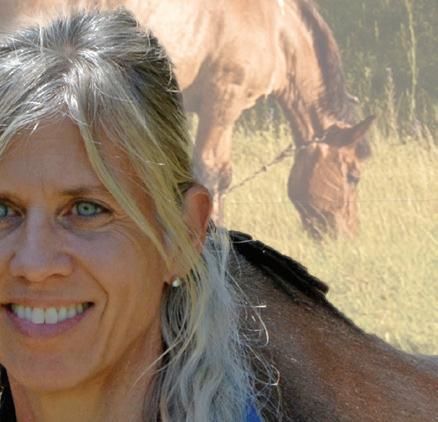
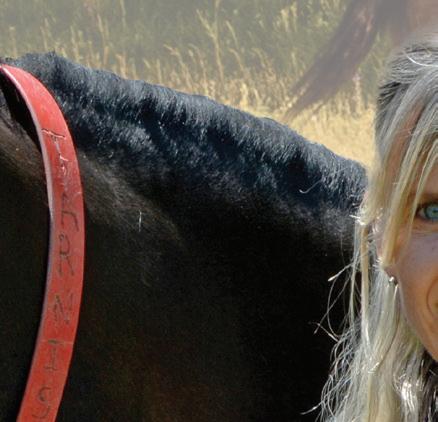

Practice type: 90 percent equine with small ruminant component




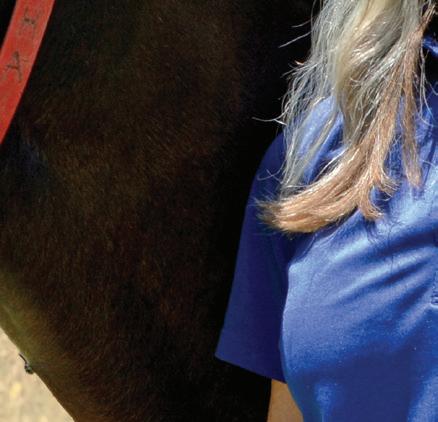






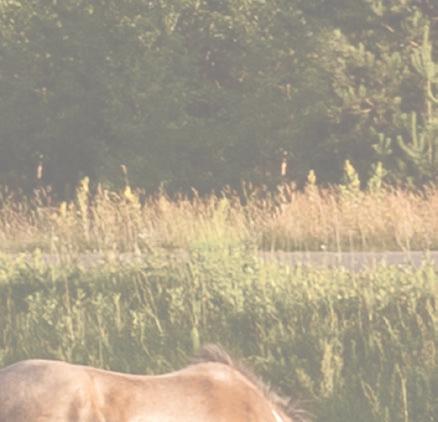





UC Davis School of Veterinary Medicine


Where would you go if you could go anywhere and why?
Why are you a CVMA member?
I appreciate the value of organized veterinary medicine and the positive change it can foster. As an equine veterinarian, I value greater coordination between practitioners, especially in times of disaster.
Which area of veterinary medicine would you like to explore?

I have a goal to attain certification in equine sports medicine and rehabilitation. I truly believe in the long term welfare implications of injury prevention in horses, and diagnostic and biological treatment options are rapidly advancing. advancing.
How do you keep your workplace fun?
I remember to choose kindness above all else. If we can navigate the day with a sense of humor and humanity, then it’s a good day.
Napili, Maui It is one of the few places I can go year after year to enjoy nature and truly unwind.
Do you have an unusual hobby or interest?
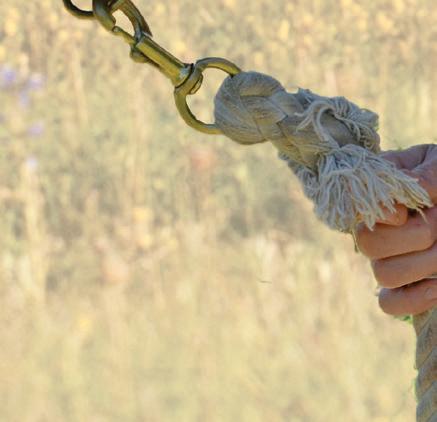
When I am not vetting horses, I enjoy riding them. When I am on my horse, I am truly in the moment…which is a gift in this fast-paced world.




California lawmakers submitted over 2,000 bills for the 2021 legislative cycle. CVMA lobbyists Mike Dillon and Christina DiCaro reviewed each bill to find any that could potentially impact the veterinary profession or animal health and welfare. The CVMA Legislative Team - which includes CVMA lobbyists, Executive Committee, key staff, and CVMA Legislative Committee Chair Dr. Dayna Wiedenkeller, met on February 26 to determine which bills should move onto the CVMA Legislative Committee for review. The CVMA Legislative Committee will meet on March 12 to discuss over 40 bills and to make position recommendations which will be presented to the CVMA Board of Governors. The Board will vote on official CVMA bill positions at their March 20 meeting. The CVMA Legislative team will closely monitor bills of interest through the 2021 legislative cycle and represent the CVMA to legislators, bill sponsors, and other stakeholders.
The CVMA has been actively involved in the issue of animal blood banking since 2019 when both Assemblymember Bloom and Senator Wilk separately introduced legislation to address community and closedcolony canine blood banking in California. To date, legislation has not yet been passed to address concerns over California’s two closed-colony blood banks. This year, Assemblymember Bloom, along with Senator Wilk as a coauthor, has introduced legislation that will phase out the two closed-colony blood banks and replace them with establishments that collect blood from communitysourced animals. The CVMA is engaging stakeholders on this issue to represent the needs of the veterinary profession in preserving a safe and adequate supply of blood and blood products.
The Assembly Business and Professions Committee and the Senate Business, Professions and Economic Development Committee periodically hold joint sunset oversight hearings to review boards under the Department of Consumer Affairs (DCA). The sunset review process provides an opportunity for the DCA, the Legislature, the boards, and interested parties and stakeholders to discuss the performance of the boards and make recommendations for improvements. The California Veterinary Medical Board (VMB) is being reviewed in 2021, and the VMB’s report to the Sunset Review committee is posted on the VMB website. The CVMA also submitted a letter to the Sunset Review Committee with comments on issues addressed by the VMB in its sunset review report. The CVMA will be representing the profession throughout the sunset review process.
Current law permits veterinarians to discuss the use of medicinal cannabis for animal patients with clients, but prohibits cannabis recommendation. Over the past two years, an unsuccessful attempt was made in the form of SB 627 (Galgiani) to permit veterinarians to recommend cannabis. This year, Assemblymember Ash Kalra has introduced new legislation to permit recommendation. Mr. Kalra is experienced in this subject, as he previously carried the legislation that allowed veterinarians to discuss cannabis. The CVMA will work closely with Mr. Kalra and his staff to represent the veterinary profession on this issue.
This bill would expand existing legal definitions pertaining to pet insurance in reference to medical advice, diagnosis, care, and treatment. Specifically, the bill would require pet insurance policies issued, amended, or renewed in California to provide full coverage for sterilization surgery
and veterinary expenses associated with the procedure. The bill would also require a 20-day notice of cancellation of a pet insurance policy, or at least 10 days’ notice in cases of nonpayment of premiums or of fraud.

AB 1102 (Low) Telephone medical advice services. This bill would specify that a telephone medical advice service is required to ensure that all health care professionals who provide telephone medical advice services from an out-of-state location are operating consistently with the laws governing their respective licenses. The bill will also require such services to comply with all directions and requests for information made by the respective healing arts licensing board. Because the veterinary profession is defined in statute as a healing arts profession, this bill would impact businesses that offer veterinary advice.
January 10 – Deadline for Governor to submit budget
January 11 – Legislature reconvenes
February 19 – Last day for bills to be introduced
June 4 – Last day for bills to pass out of house of origin
July 14 – Last day for policy committees to meet and report bills


September 3 – Last day to amend bills on floor
September 10 – Last day for each house to pass bills
October 10 – Last day for Governor to sign or veto legislation
For specific information on bills or to track CVMA-monitored bills through the legislative process, visit the CVMA’s online Legislative Action Center, which now has a new look and format. The Voter Voice platform makes searching for relevant legislation easier and is now more user-friendly. Check out the improved format by logging onto cvma.net and clicking on the Government tab.


Registered Veterinary Technicians (RVTs) are valuable members of the veterinary practice team whose role is constantly expanding as the profession continues to develop and grow. The RVT profession is steadily mastering new skills that contribute to animal care and wellbeing, and help veterinary practices to serve the needs of the community. Yet a recent survey conducted by the CVMA indicates that RVTs are not being used to their fullest potential in many veterinary practices and that RVT wages are static. This article will explore these issues and offer options to address them.
According to the California Veterinary Medicine Practice Act, there are three defined titles in veterinary practice: veterinarian (DVM), registered veterinary technician (RVT), and veterinary assistant (VA). The practice act states that only veterinarians may perform the following: surgery, diagnosis and prognosis of animal diseases, and prescribing of drugs, medicine, and appliances.
When comparing RVTs and VAs, the difference between the two positions can be unclear to some. One may argue that other than nomenclature, there is no difference. However, an RVT can only obtain licensure after graduating from a minimum of a 2-year accredited veterinary technology program or an equivalent alternate route program and passing the Veterinary Technology National Exam (VTNE). RVTs must also maintain licensure by completing a minimum of 20 units of qualified continuing education every two years. Additionally, as part of the licensing requirements, RVTs must submit their fingerprints and are subject to an extensive background check. In contrast, no formal education or licensure is required to be a VA.
California law states that an RVT may perform certain tasks that VAs may not. This authorization is granted to RVTs because of their formal and continuing education. The following tasks are specifically mentioned in the law:
• Induce anesthesia
• Apply casts and splints
• Perform dental extractions
• Suture cutaneous and subcutaneous tissues, gingiva, and oral mucous membranes
• Create a relief hole in the skin to facilitate placement of an intravascular catheter
Also, under emergency conditions, an RVT may render specified lifesaving aid and treatment when a veterinarian is not immediately present, provided that required conditions are met.
According to the California Employee Development Department, the average 2020 salary for an RVT was $21.35 per hour or $44,408 annually. For a VA, the average was $16.68 per hour, or $34,694 annually, despite RVTs being able to perform several tasks that VAs may not, and despite the formal primary and ongoing continuing education requirement needed to be an RVT.
In 2020, RVT biennial license renewal fees more than doubled increasing from $160 to $350, which placed a considerable financial strain on the profession when added on top of ongoing continuing education expenses. Thus, it is financially more challenging than ever to maintain an RVT license, with little incentive to do so given that RVTs only make roughly $10,000 more than an unlicensed practice employee.

The CVMA Economic Issues Report was published in early 2020 and included responses from nearly 700 California RVTs. According to the report, veterinary practices are busier than ever, veterinary practice revenues are up, and veterinarians are taking home more money. Yet, between 2016 (when the previous study was

conducted) and now, RVT salaries have remained flat. This data is disturbing. While it costs more than ever to be an RVT in California and practices are making more money, RVT compensation is not rising enough to show a material increase in average pay.
The report also indicated that 70% of RVTs did not feel confident that they could make a good living working as an RVT.
The Economic Issues Report also revealed that over one out of every three RVTs who completed the survey expressed dissatisfaction with the opportunities for professional growth offered by their employer.
Regarding utilization of RVT skills, the report found that 94% of RVTs induce anesthesia, 65% apply casts and splints, 61% perform dental extractions, 58% suture skin, subcutaneous tissue, and gingiva, and 57% create catheter relief holes. The low reported rates by which some of these tasks are performed indicate that either 1) veterinarians are performing these tasks, or 2) VAs are (illegally) performing them. In the case of the former, every time a veterinarian performs an RVT task, the practice loses revenue and misses an opportunity to utilize a skilled and credentialed RVT to their fullest extent. In the case of the latter, all parties are at risk when an unlicensed person is performing tasks outside that which the law permits. This can harm client relationships, the practice’s reputation, employee morale, the supervising veterinarian’s license, and—most importantly—animal patients.
Although RVTs perform technical duties in practice, they can also further their education, training, and experience to advance in the profession. Through the National Association of Veterinary Technicians in
America (NAVTA), there are 16 specialty certifications available to RVTs. Also, the Veterinary Hospital Managers Association offers credentialing as a Certified Veterinary Practice Manager (CVPM), which is available for RVTs to pursue once they meet the eligibility requirements.

How can we ensure that RVTs are paid wages that reflect their required education, training, and licensure, and that these wages include yearly increases that address cost of living and inflation?
First, RVTs should be allowed to perform tasks commensurate with their knowledge, skills, and training, which are permitted by law. Second, RVTs need growth opportunities in practice to further develop and advance in their careers as licensed professionals.
Too many RVTs leave our profession because of poor pay and lack of growth opportunities. Now is the time to adequately compensate and advance RVTs in practice to benefit not only the RVT profession but also the entire practice team.
Laressa Dimalanta is a Hospital Manager at a corporate-owned small animal hospital in the Bay Area and is a visiting instructor for the veterinary technology program at a local college. She has over 20 years of experience as an RVT in research, academia, and general practice. She has served on the CVMA RVT Committee since 1999 as the past Research RVT and Education RVT, and currently as the District IX (San Mateo, San Francisco, and Santa Clara counties) RVT Representative. She is also a member of the California Veterinary Medical Reserve Corps and plans to take the CVPM licensing exam next year.

COVID-19 has dramatically impacted most businesses. Although veterinary practices have demonstrated great resilience in surviving the pandemic, the impacts are considerable. Processes have changed from before the patient enters the clinic until the patient is returned to its owner. The physical, mental, and logistical impacts of the virus itself are considerable. Given these far-reaching general impacts of COVID on veterinary practice, it is a challenge to focus on and address the range of COVID-related legal issues. Moreover, legal issues and guidance around COVID are changing as rapidly as the challenges the pandemic presents.
The Families First Coronavirus Relief Act (“FFCRA”) came into effect on April 1, 2020. Businesses scrambled to adopt the FFCRA without receiving clear guidance. Then, once we developed an understanding on how to approach FFCRA leaves, the FFCRA was replaced in December 2020 by hastily-enacted legislation. The new federal administration is contemplating additional changes that may be put into effect before any guidance is offered on the December 2020 legislation, and before this article is published. State laws will undoubtedly follow, and individual counties have not been bashful in issuing their own guidance or orders. In short, things are changing quickly. So where do we start?
The best approach for the veterinary profession is to (1) be nimble, (2) rely on available resources, and (3) take defensible positions.
The veterinary industry has adapted to COVID better than most. This is not happenstance. Credit must be given to vet-

erinary practices for identifying the aspects of the practice impacted by COVID and initiating changes to address them. The simple change to curbside pick-ups afforded protection to owners and staff. Unfortunately, mandates for social distancing and employee absences due to necessary quarantine or actual illness have been problematic and in some instances have forced clinics to close. As the challenges posed by the pandemic continue to evolve and knowledge regarding COVID grows, the approach to responding to COVID-related impacts must also evolve. Veterinarians, as individuals and as a profession, must continue to identify changes and take action. It is the failure to adapt that can create legal issues and jeopardize safety.
COVID has turned many aspects of business management—particularly employment practices—upside down. The numerosity and ever-changing nature of issues resembles “whac-a-mole” while the guidelines for addressing these issues are insufficient. The rights and obligations of employers and employees are unclear in these unchartered waters. Adding to the uncertainty are real health fears, political overlays, and religious beliefs.
Whether you are an employer or an employee, you must be nimble. Anticipate that there will be changes and be flexible to adopt changes. The saying “we are all in this together” applies to the workplace.

Multiple governmental agencies have responded to the pandemic by enacting regulations and guidance that in some instances not only overlap, but may be inconsistent. Both the federal and California governments have enacted statutes
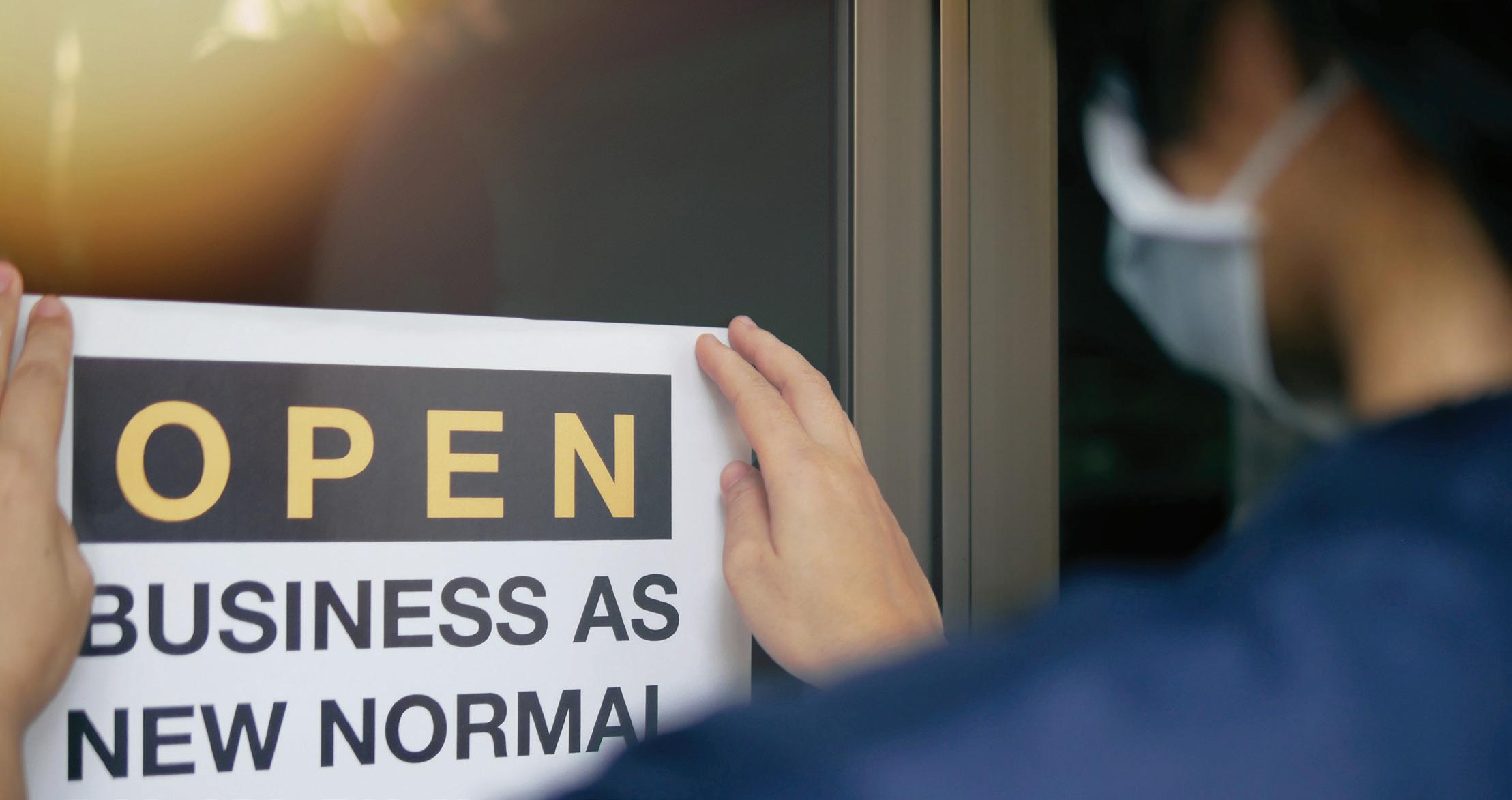
focused on COVID-related issues generally and workplace-related issues specifically, such as the FFCRA. These statutes are products of expedited legislative processes and were intended to address immediate issues, which, as we have learned, may quickly change. To implement these statutes, federal and state administrative agencies—notably the U.S. Department of Labor and Cal/OSHA—issued emergency regulations that were not fully vetted through the normal administrative process. Generally, regulations are to be afforded the power of law, but are subject to challenge if they are inconsistent with the statutes already in place.
Additionally, some governmental bodies have issued guidance, such as the Center for Disease Control and Prevention’s guidance regarding the response to COVID exposure and illness in the workplace. There have also been a number of executive orders issued by the California governor. In some cases, however, it is unclear whether these orders are enforceable directives or mere guidance. Confused? There’s more! California counties have also been active in enacting their own ordinances, which may be enforced by those counties as well as orders and guidance, the enforceability of which are unclear.
When confronted with a COVID-related issue, such as employees testing positive or being forced to quarantine, where do we turn for help? There is no clear path; and there may be no clear answer. There are some resources, however, to consider including:
CVMA’s Website (cvma.net) –The CVMA has been proactive in posting and updating COVID-related information for members on its website. As information specific to the veterinary industry, it is a good “first stop.”
CDC Website (cdc.gov) –The CDC’s website contains information and “guidance” regarding the handling of COVID in the workplace. This “guidance” is not legally enforceable, but establishes standards and, arguably, “best practices.”
U.S. Department of Labor Website (dol.gov) – The U.S. Department of Labor issued emergency regulations regarding the FFCRA expanded sick leave and family leave. Although the initial FFCRA leaves expired on December 31, 2020, an optional sick leave program continues through March 31, 2021. By the time this article
is published, there may be new programs administered by the Department of Labor.
California Department of Public Health (CDPH) (cdph.ca.gov)
The “COVID-19 Employer Playbook” was published on September 25, 2020 by the CDPH, and is designed for businesses reopening after a shutdown.
Department of Industrial Regulations – Cal/OSHA Emergency Regulations (dir.ca.gov) – Cal/OSHA has issued a series of mandatory, workplace-focused “standards” addressing social distancing and other COVID-related safety protocols, COVID reporting, workplace responses to exposures, and closures.
California Coronavirus Website (covid19.ca.gov)
An ever-changing montage of information for employers and employees.
County Health Departments – Most counties have websites containing local ordinances and guidance ranging from rent protections to information regarding sick leave. Many county health departments also provide telephonic guidance, particularly concerning COVIDrelated health issues.
Because of the dynamic nature of the pandemic, even the best resources can sometimes be of little assistance. In scenarios that are novel or where guidance is contradictory, the best approach is take a defensible, “safety-first” position. A defensible position is one that is based upon— even if it does not exactly follow—generally accepted authorities, including laws, regulations, ordinances, orders, and guidance. Depending on the situation a practice may be facing, there may be different options presented. At that point, reasonable judgment emphasizing safety should be used. In the end, the rationale for actions should be documented along with references to the resources supporting the decision.
The challenges of this pandemic are unprecedented. Avoiding legal issues will require both employers and employees to respond nimbly to those challenges, consider the resources available, and—if a path is not clear—be flexible in taking a defensible, safety-centric position based upon relevant laws, regulations and guidance.

Veterinarian
Dr. John Abella
Dr. Tamara Abraham
Dr. John Ashbaugh
Dr. Charles Baek
Dr. Terri Becker
Dr. Christina Bradbury
Dr. Louis Burch
Dr. Erica Burkland
Dr. Louisa Cammidge
Dr. Ericka Carroll
Dr. Daniela Castillo
Dr. Kelly Cha n
Dr. Sandeep Cheema
Dr. Harmanpreet Chhina
Dr. Hui Chin
Dr. Jaewon Choi
Dr. Laura Clark
Dr. Ann Craig
Dr. Rebecca Csomos
Dr. Severino de las Alas
Dr. Jessica Dewar
Dr. James Dunlap
Dr. Tracy Duprez
Dr. Barbara Dworak
Dr. Cynthia Easton
Dr. Matthew Eliott
Dr. Dominique Engel
Dr. April Ervin
Dr. Christin Fahrer
Dr. Caroline Fallon
Dr. Ryan Gershenson
Dr. Shavit Gonen-Fine
Dr. Pamela Green
Dr. Vani Guttikonda
Dr. Suzanne Hange
Dr. Catherine Hedden
Dr. Carl Jameson
Dr. Je rey Jenkins
Dr. Caroline Jurney
Dr. Karalyn Kane
Dr. Scharlet Kelly
Dr. Elizabeth Killham
Dr. Jung Hoon Kim
Dr. Mimi Kim
Dr. Erin Kishi
Dr. Hani Korani
Dr. Nathan Kotschwar
Dr. Michelle Ku
Dr. Katie Lee
Dr. Helene Letessier-DeWynter
Dr. Allison Leuin
Dr. Catherine Lorenz
Dr. Hilary Ludwig
Dr. Leejoan Ma
Dr. Elyse Math
Dr. Anna McKeever
Dr. Erin McNally
Dr. Erin McNeill
Dr. Emily Moeller
Dr. Shannon Mulcahy
Dr. Marc Myers
Dr. Alexander Nicki
Dr. Odette O
Dr. Jamie Ota
Dr. Stephanie Paclot
Dr. Theresa Pancotto
Dr. Sophia Papageorgiou
Dr. Glenn Park
Dr. Erin Paster
Dr. Allison Pope
Dr. Heather Puksta
Dr. Kerry Rapacz
Dr. Sirithorn Ratanapreukskul
Dr. Anne-Marie Reikes
Dr. Kevin Render
Dr. Kyle Ross
Dr. Noelle Schoettle
Dr. Nirip Shokar
Dr. Timothy Shu
Dr. Kelly Sigle
Dr. Karen Soares
Dr. Anne-Marie Sostrin
Dr. Mariko Soto
Dr. Petra Tavano
Dr. Morgan Taylor
Dr. Michelle Tieu Lopez
Dr. Jordan Vendramin
Dr. Kenneth Verdin
Dr. Christine Vogt
Dr. Christina Vos
Dr. Kacie Woodward
Dr. Winnie Ybarra
Dr. Andrew Zuckerman
Dr. Nicole Anderson
Dr. Nichole Arbona
Dr. Jessica Aulestia
Dr. Hannah Bachman
Dr. Emily Bloom
Dr. Nicole Cady
Dr. Nathan Cherzan
Dr. Allani Delis
Dr. Yanni Dzoan
Dr. Samantha Ekman
Dr. Frances Fan
Dr. Stephanie Ferreira-Nichols
Dr. Cooper Hasselbrink
Dr. Katharine Haughton
Dr. Alaina Hiteshew
Dr. Georgina Hook
Dr. Elizabeth Hoose
Dr. Stephanie Huang
Dr. Sylvia Kim
Dr. Lauren Kramer
Dr. Laurel Krause
Dr. Wen Chi Lee
Dr. Adriana Lopez Nieves
Dr. Rachel Mar
Dr. Savannah McCurdy
Dr. Jenna Pham
Dr. Charlotte Pyle
Dr. Hailee Serafin
Dr. Kelsey Stickler
Dr. Adam Tate
Dr. Emily Teng
Dr. Laura Trujillo
Dr. Elaina Valencia
Dr. Madison VanWorth
Dr. Kuo-Yang Wang
Dr. Mengyue Wang
Dr. Connie Wu
Veterinarian 2nd Year Graduate
Dr. Julia Antczak
Dr. Allison Brown
Dr. Paulina del Castillo Anaya
Dr. Eliana Gonzalez
Dr. Sarah Haddy
Dr. Yin Wa Brontie Kong
Dr. Deborah Krimsley
Dr. Kathleen Kuperman
Dr. Colleen Lyons
Dr. Rebekah Parker
Dr. Morgan Ramos
Veterinarian 3rd Year Graduate
Dr. Stephanie Hatayama
Dr. Ashley Higgs
Dr. Keaton Massie
Dr. Melodie Messer
Dr. Andrea Montano Hernandez
Dr. Alexis Schultz
Dr. Anjali Shrestha
Veterinarian 4th Year Graduate
Dr. Sydney Bridge
Dr. Jillian Celestino
Dr. Vihaney Graves
Dr. Lori Hammond
Dr. Mangala Krishnappa
Dr. Nicole Mikoni
Dr. Lauren Munchel
Dr. Jairo Rivera Posada
Dr. Kelly Rockwell
Dr. Robert Slater
Dr. Laura Whitelaw
Veterinarian Public Service
Dr. Ami Mehta
Dr. Mary Stice-Kishiyama
Veterinarian Faculty
Dr. Lu Dao
Dr. Helen Engelke
Dr. Ashley Hill
Veterinarian Intern-Resident
Dr. Julia Bergen
Dr. Ariel Loredo
Registered Veterinary Technician
Amy Abel, RVT
Kimberly Acosta, RVT
Diamonique Allen, RVT
Mariah Bailey, RVT
Danyelle Benware, RVT
Christopher Bertroch, RVT
Kimberly Blaquera, RVT
Elise Burgess, RVT
Sabrina Castaneda, RVT
Mirella Ceja, RVT
James Champion, RVT
Leah Copass, RVT
David Corrales-Roldan, RVT
Meghan Dailey, RVT
Alexandra Davie, RVT
Jennifer Dawson, RVT
Jennifer Devera, RVT
Camille Drugé, RVT
Sandra Engelmeyer, RVT
Jessica Enright, RVT
Erik Fausak, RVT
Patrick Fung, RVT
Monica Gomez Torres, RVT
Kathleen Gudiel, RVT
Janel Guerra, RVT
Aimee Guy, RVT
Jaqueline Ha, RVT
Tammy Hampton, RVT
Francesca Hardy-de Boisblanc, RVT
Muriel Harman, RVT
Roxanne Harmse, RVT
Shelby Hennick, RVT
Myra Herbert-McHenry, RVT
Heidi Holtz, RVT
Sarah Horsley, RVT
Susannah Jensen, RVT
Katy Kaabe, RVT
Kimara Kavanagh, RVT
Sally Kawano, RVT
Soo Kwon, RVT
Chloe Lor, RVT
Amber Lory, RVT
Elizabeth Martinez, RVT
Shannon McCarroll, RVT
Kelly McGraw, RVT
Sarah McMillen, RVT
Sienna Meneses, RVT
Lynsey Menicucci, RVT
Joy Middleton, RVT
Allan Molina, RVT
Sabina Mondragon, RVT
Hailey Mujagic, RVT
Ashley Mundis, RVT
Jennifer Narbonne, RVT
Lorena Pena, RVT
Kris Petersen, RVT
Emerald Peterson, RVT
Megan Phillips, RVT
Felicia Pierce, RVT
Brittany Post, RVT
Bonnie Powell, RVT
Elias Preciado, RVT
Nicole Reynolds, RVT
Ashley Rich, RVT
Jennifer Rodas, RVT
Maria Schoenecker, RVT
Shelby Schreck, RVT
Paulina Simmavong, RVT
Andrea Snable, RVT
Leeanne Stephens, RVT
Jennifer Strong-Pardus, RVT
Ashley Taylor, RVT
Candace Taylor, RVT
Kristen Taylor, RVT
Katarina Thomas, RVT
Richele Tucker, RVT
Sarah Twitchell, RVT
Wendy Ventura, RVT
Alma Ventura, RVT
Elizabeth Voelker Myers, RVT
Jill Walsh, RVT
Heather Wheeler, RVT
Cielle Williams, RVT
CVMA Certified Veterinary Assistant

Je rey Burns, CVMA CVA
Natalie Chang, CVMA CVA
Vivian Davis, CVMA CVA
Shan de Wey, CVMA CVA
Jessica Hammer, CVMA CVA
Emma Rademaker, CVMA CVA
Veterinary Hospital Staff
Michael James
Sasha Reid
Brandy Robison
Non Resident Veterinary Student
Samantha Zuniga
Become
Join the CVMA today and save on our upcoming CE offerings, products, and services.
For more information about the CVMA and CVMA member benefits and services visit cvma.net.
Join Today!
How to join:
Online at cvma.net.
Complete a membership application available at cvma.net and mail to 1400 River Park Drive, Suite 100, Sacramento, CA 95815
Email membership@cvma.net
® Connect
The CVMA extends our sincere sympathy to the friends and family of those remembered.
Dr. William Pritchard, a CVMA Life member and former Dean of the UC Davis School of Veterinary Medicine, passed away on October 18, 2020. He received his DVM from Kansas State University in 1946, his doctorate from the University of Minnesota in 1953, and his doctorate of jurisprudence from the University of Indiana in 1957. Dr. Pritchard began his tenure as Dean of the UC Davis School of Veterinary Medicine in 1962, serving in that capacity until 1982. Dr. Pritchard remains the longest-serving Dean in the history of the school. In 1966, Dr. Pritchard testified before the U.S. House of Representatives regarding the future of veterinary education and is credited with helping to gain federal funding for veterinary schools and teaching hospitals in the United States.
It is unfortunate that even with safety measures in place, injuries occasionally occur at work. Staff and management need to know what to do if someone sustains an injury while performing their job duties. Prompt reporting of an injury is essential and affords numerous benefits for the injured worker as well as the practice owner.
Immediate reporting of a workplace injury to management and the insurance company means the best possible care for the injured worker can be provided quickly. Timely medical treatment by specialty providers familiar with treating work-related injuries increases the likelihood of proper diagnosis and effective treatment plans. Usually minor injuries, when treated right away, tend to stay minor and heal faster. Early treatment provides greater opportunity for the employee to return to work sooner.
Prompt reporting to the insurance carrier permits the claim representative to immediately communicate with the injured staff member, management, and physician in an attempt to facilitate return to work. Doing so reduces the number of days of lost time paid.
Immediate reporting of an accident or even a “near miss” will quickly enable the practice to examine hazards and risky employee behaviors with the goal of preventing similar future incidents. The practice’s safety coordinator should immediately conduct a thorough investigation of the accident to expose the cause. The accident
investigation is a fact-finding, not fault-finding process which will determine how to prevent a similar incident in the future. Talking to the injured employee and other staff members who may have witnessed the incident right away will help obtain the best picture of what actually happened before memories fade.
The laws that apply to reporting a work-related injury have specific time frames that the employer and insurance company must meet. The clock begins ticking when the employer obtains knowledge of a work injury or illness that requires medical treatment beyond first aid or results in lost time.

Under California law, the insurance carrier has 90 days from the employer’s date of knowledge of an injury to investigate the claim to determine if what is alleged actually occurred.
In some cases, a reason for not reporting an injury could be the fear of consequences. Injury reporting must be non-punitive. Team members must not deem that reporting a workplace injury will result in embarrassment, retaliation, or loss of employment. Management must demonstrate their commitment to a non-punitive system and should ensure that all employees know and understand reporting requirements if they are injured or involved in an emergency.
Information provided by Preferred Employers Insurance, a Berkley Company.
With extended droughts and rising temperatures, the duration and intensity of California’s fire season is increasing. California faced its worst wildfire season on record in 2020. It was not only the number of fires, totaling nearly 10,000 incidents, but the scale of damage. Over 4 million acres burned, which was double the previous annual record. Six of the top 20 largest fires ever recorded in the state occurred in 2020 and resulted in injuries, loss of life, and massive personal and professional property loss.
Whether your practice is established or just starting, you likely carry business personal property insurance coverage, commonly known as “contents” coverage. Veterinary “contents” generally consist of the following:
• Medical equipment, and related tools, attachments, etc.
• Office equipment – computers, desks, chairs, phones, books, janitorial, etc.
• Supplies – office and medical, surgical packs, disposables, etc.
• Inventory – drugs (prescription and nonprescription) and products, retail items, food, etc.
• Fixtures, furnishings, or improvements – installed at your own expense
basis. Remember, your coverage limit is commonly capped at the total contents amount purchased and may also be subject to a deductible.
Should your practice sustain an unfortunate incident requiring a need to file a property insurance claim with your insurance carrier, it is important to have an accurate, current, and detailed property insurance inventory list on hand. Maintaining a pre-prepared inventory will not only assist the insurance company in assigning a more accurate replacement value for your property, it will be one less thing to worry about in an already-stressful situation.
Here are a few tips when completing your inventory:
• Provide a clear written description of each item, including serial numbers where applicable. For items of value lacking serial numbers, consider engraving your own numbers, and recording them in your inventory.
• Note the cost of each item and date acquired, or— even better—keep the pertinent sales receipts. If you are unsure of the replacement value of any of your items, inquire with your vendors for assistance and document your inventory list accordingly.
• Keep a video inventory or photographs in addition to a written inventory.
• Update your inventory list regularly throughout the year. Consider doing a “sweep” of your practice at defined intervals during the year to ensure that new items are captured and discarded items removed from your inventory lists.
Your inventory can be maintained in any one of several ways—PC Hard Drives, USB, scan disks, zip drives, or written format. Regardless of your recordkeeping method, keep your inventory list and supporting materials in a safe location such as a bank or fireproof lockbox, online storage, or other location away from your business operations.
The recommended insurance valuation method when covering your contents is a “replacement cost” valuation. This valuation method makes certain that your contents are replaced without depreciation, provided you actually replace the property. Should you choose not to replace, the claim is settled on an actual cash value or depreciated
Compiling an inventory list can be relatively simple. Do not put it off. Start with your larger ticket items and work from room to room. Once complete, compare the total inventory value against the business personal property coverage limit on your current insurance policy. Keep in mind that you may require an adjustment to be adequately insured.
“Should your practice sustain an unfortunate incident requiring a need to file a property insurance claim with your insurance carrier, it is important to have an accurate, current, and detailed property insurance inventory list on hand.”
This profession can be tremendously rewarding but it can also be incredibly taxing, both mentally and physically. This series—Renew—explores wellness for veterinary professionals from a variety of angles...physical, mental, and emotional. We hope these articles provide both insight and inspiration for a lifetime of wellness and renewal.




As veterinarians, we’re already high achievers. We checked all the boxes to get through school. We don’t like to give less than our best. We’re problem solvers. We help animals feel better, and if we can’t, there better be a dang good reason.
It’s no wonder we punish the heck out of ourselves when we can’t seem to fix our own behavior.
I’ve said things like these, and I’m betting I’m not alone. “I was so bad this weekend. So much for my diet.” “I joined the gym and haven’t gone once. I suck.”
Our culture teaches us to think in black and white where food and exercise are concerned. From TV to magazine covers to Instagram, we’re told we’re “good” if we behave one way and “bad” if we fall into other patterns.
I think this is hogwash.
Here are some facts about me: I stay up too late for no reason. I spend too much time on my phone. I do most things at the last minute.
Here are some other facts about me: I exercise at least 5 times a week. I never get caught without nutritious meals and snacks. I finish all my charts on the same day.
These are not my good and bad qualities. People see my finished charts, workout logs, and lunch bag full of

food and tell me they envy my discipline. But I’m the same person who stays up till midnight watching The Office, frantically pays bills on the 31st, and won’t show anyone my screen time summary out of shame. If I’m so disciplined, why are those things also true?
Here’s a secret: What looks like discipline or motivation (“good qualities”) is often actually habit – just like mindless scrolling. And we develop a habit when we repeatedly do something, whether we mean to or not.
You CAN make healthful habits stick! Here are some tips:

Start REALLY small - and be specific. Saying, “I’m going to work out every day” will probably end up in habit purgatory, because there’s no support: Where? When? What if I’m tired? How much time do I need?
Instead, try “I will do 10 squats every time I get back to my desk.” Before you know it, you might go for 20.
Get yourself some accountability.
Especially when it comes to health and fitness, it’s easy to feel sabotaged or judged by people who may not have the same goals (“Come on, have another cookie with me!”) or when we fear ridicule (“SHE’S trying to lose weight?”). Having a person or group, even online, who not only supports your goals but WANTS you to check-in, can make a huge difference. Knowing someone isn’t tired of hearing about your meal prep or wants to know how many times you did yoga this week can be the difference between sticking to a new habit or letting it go.
Forget about “good” and “bad” behavior. You’re not a better person if you pack a nutritious lunch, and you’re not a worse person if you eat pizza from the lunchand-learn instead. Shaming yourself into changing is not any more helpful than if you tried to change someone else’s behavior that way. It might work in the short term, but it won’t make you any friends. And don’t you want to be your own friend?

Habits that stick are about identity, not goals.
When I was telling myself, “I need to lose weight,” I never stuck to a workout routine. Partly it was because that wasn’t a good enough reason – it was too easy to give in when I was hungry or busy or felt the couch calling. But mostly it was because, in my mind, I was A Lazy Person, not A Person Who Works Out Regularly. Once I began to think of myself as someone who enjoyed exercise, that shift in identity led to a lot of other things that seemed impossible once: I became A Person Who Runs Marathons, A Person Who Teaches Dance Fitness, and A Person Who Does Pull-Ups
Also, the strangest thing happened somewhere along that journey. When I realized my preconceived notions
about myself could be wrong, I gained confidence in my ability to change. I became A Person Who Loves Public Speaking and A Person Who Knows How to Say No, and my professional life changed completely for the better. I have no doubt I could also become A Person Who Goes to Bed Early – I just haven’t gotten there yet. (Plus, I really love The Office.)
The first barrier to any habit is how you see yourself. Once you realize you can choose to change your behavior, you might be amazed by who you really are.
Katie Berlin, DVM, NASM-CPT
Katie Berlin, DVM, NASM-CPT is an associate veterinarian in York, Pennsylvania and a veterinary officer at Clinician’s Brief. She is an optimist, podcast junkie, book nerd, and lover of all things running and fitness. She has a personal training certification and teaches group fitness. She recently launched The Vet Reset Podcast where she focuses on the intersection between physical and mental health and the importance of prioritizing both in our roles as veterinary professionals. You can also find her on the Veterinary Super Friends Podcast with Dr. Carrie Jurney of Not One More Vet, and on Facebook and Instagram @thevetreset.
May is Mental Health Month and we would like to share tips from you—our readers—on how you cope with the stresses of your profession and life. We will share select tips in the MayJune issue of the California Veterinarian. Please email your tips to Kristen Calderon at kcalderon@cvma.net by April 5, 2021.
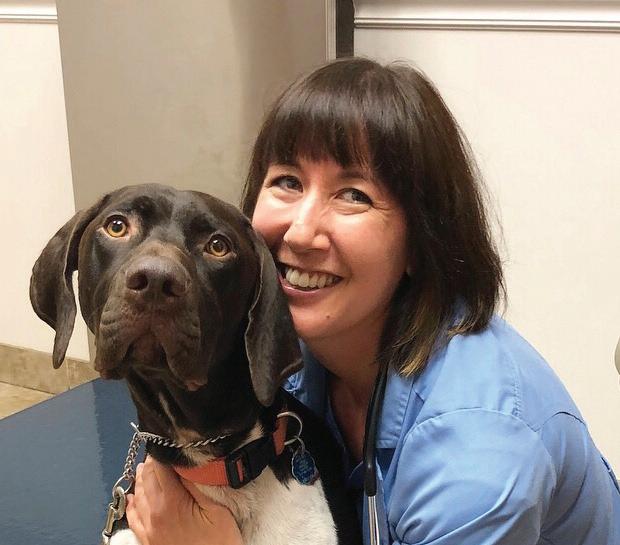
This wellness series is proudly brought to you by a sponsorship from Boehringer Ingelheim Animal Health.
The inland, or central, bearded dragon, Pogona vitticeps, is the most popular reptile pet. Many beardies come from California and, perhaps ironically, none are imported from the central inland desert of their Australian homeland. Because most diseases in beardies arise from poor husbandry, it is essential that veterinarians be the educational source for owners and advocates for good care.

Bearded dragons are omnivores, eating a mix of insects, leafy greens, flowers, and commercial pellets in captivity. Fruits and starchy vegetables are not recommended as they are not part of their natural diet, and their high sugar content promotes obesity and dental disease.1 A wide variety of insects should be fed. Be aware that insects are nutritionally inadequate at purchase and need to be fed a calcium and multivitamin enhanced diet for a day or two
before being consumed (gut-loading) by the beardie, as well as dusted with calcium just prior to feeding. Most owners are unaware that feeding insects is not the same as gut-loading insects. Juveniles can be fed once daily; adults should only be fed every 2 to 3 days; owners should avoid overfeeding and hand, or tong, feeding. Vertical climbing areas provide exercise as well as good environmental enrichment. Bearded dragons need to hibernate from December through February to metabolize coelomic fat reserves. Because obesity is the norm for bearded dragons, hepatic lipidosis is prevalent. Constipation is also a common problem. Beardies do not like to drink from water bowls, which is not surprising given their desert origins where standing water is rarely encountered. Soaking beardies in shallow water several times per week while sprinkling water on their head encourages water consumption and discourages constipation.
Parasites with direct life cycles are prevalent in bearded dragons, especially coccidia and pinworms. Both parasitic infections respond well to ponazuril and fenbendazole treatment, respectively, provided that the beardie and environment are also cleaned. Cryptosporidiosis is uncommon and difficult to cure. Hepatic lipidosis diagnosis is straightforward but difficult to manage. Nutritional secondary hyperparathyroidism is another avoidable, but common, disease. Atadenovirus infection can cause widespread juvenile morbidity and mortality and adult neurologic disease. Although we have no treatments for atadenovirus, PCR colonic testing is recommended; positive animals should be isolated and not bred. Concerted veterinary efforts can reduce atadenovirus prevalence, much as veterinarians have done with other viral diseases. Wearing gloves while handling all dragons can prevent veterinarians from serving as atadenovirus fomites. Rectal/colonic prolapse is becoming less common as we move away from inappropriate substrates such as sand, gravel, wood chips, mulch, coconut coir, and ground walnut shells. Onygenalean fungal infection causes contagious diffuse necrogranulomatous dermatitis that is rapidly fatal. Fungal infections in beardies are typically caused by Nannizziopsis guarroi, not N. vriesii, and should not be called yellow fungal disease. Treatment using terbinafine via nebulization, implantation, or oral therapy is emerging as a safer option than the use of azoles. Agamid anatomy predisposes beardies to dental disease, which is managed through proper diet and prophylactic dental cleaning preferably prior to the occurrence of widespread osteomyelitis.1 Do not overlook it. Young female dragons not intended for breeding, or if atadenovirus positive, should be ovariectomized to prevent egg yolk coelomitis in older females and viral spread. Dragons are prone to neoplasia, especially squamous cell carcinomas, melanomas, cholangiohepatic tumors, as well as less common nerve sheath tumors, gastric neuroendocrine carcinomas (somatostatinomas), sarcomas, chromatophoromas, lymphomas, and rare lymphocytic leukemias.
This is a glimpse of what we will cover in more detail in fully interactive online presentations at PacVet Live, Friday, June 18, 2021. Geared towards busy veterinarians, we will share practical advice on husbandry, diagnostics, treatments, and techniques common to the bearded dragon. Hope to see you there - become a dragon expert!

Reference
Mott, R., Pellett, S., Hedley, J.. (2021). Prevalence and risk factors for dental disease in captive central bearded dragons (Pogona vitticeps) in the United Kingdom. Journal of Exotic Pet Medicine, 36:1-7.
Thomas H. Boyer, DVM, DABVP, Reptile and Amphibian Practice | 2021 PacVet Live Speaker
Dr. Boyer earned his DVM in 1989 from Colorado State University. He co-founded the Association of Reptilian and Amphibian Veterinarians and started the Journal of Herpetological Medicine and Surgery (JHMS) where he served as the JHMS Editor for 18 years. Dr. Boyer was one of the founding diplomates of the ABVP Reptile and Amphibian Specialty and owns the Pet Hospital of Peñasquitos in San Diego.































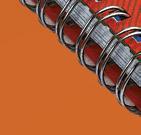








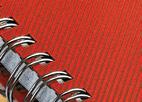
















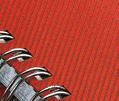

















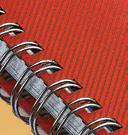






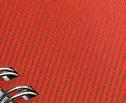
















































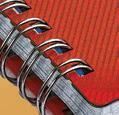




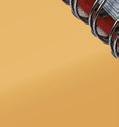







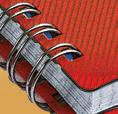














































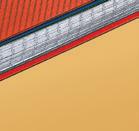



























































8:45 AM Log-in Log-in
9:00 AM–12:50 PM Topic: Pharmacology*
Jennifer Davis, DVM, Ph.D., DACVIM (LA), DACVCP
Sponsored by
1:10 PM–5:00 PM Topic: Dentistry/Practice Profitability


Mary Berg, BS, RVT, RLATG, VTS (Dentistry)
Sponsored by
Topic: Reptiles
Thomas Boyer, DVM, DABVP( Reptile and Amphibian Practice)
Topic: Radiology and Ultrasound
Kurt Selberg, MS, DVM, DACVR
Sponsored by
8:45 AM Log-in Log-in
9:00 AM–12:50 PM Topic: Ophthalmology
Sara Thomasy, DVM, DACVO, Ph.D.
Sponsored by
1:10–5:00 PM Topic: Sports Medicine and Rehabilitation
Juliette Hart, DVM, MS, CCRT, CVA, DACVSMR
Topic: Emergency and Critical Care
Jarred Williams, DVM, MS, Ph.D., DACVS-LA, DACVECC
Sponsored by MRC CA
Topic: Avian
Scott Echols, DVM, DABVP (Avian Practice)
8:45 AM Log-in Log-in
9:00 AM–12:50 PM Topic: Gastroenterology
Jacqueline Whittemore, DVM, Ph.D., DACVIM (SAIM)
Sponsored by
1:10–5:00 PM Topic: Internal Medicine
Anthony Carr, Dr. med. vet., DACVIM (SAIM)
Sponsored by

Topic: Emergency and Critical Care
Megan Brashear, BS, CVT, VTS (Emergency and Critical Care)

Sponsored by
Topic: Pain Management
Stephen Cital, RVT, RLAT, SRA, VCC, CVPP, VTS-LAM (Res. Anesthesia)
Sponsored by
8:45 AM Log-in Log-in

9:00 AM–12:50 PM Topic: Nephrology/Urology
Shelly Vaden, DVM, DACVIM, Ph.D.
Topic: Anesthesia & Pain Management
Emily McCobb, DVM, MS, DACVAA
Sponsored by 1:10–5:00 PM Topic: Soft Tissue

Sponsored by

David Upchurch, DVM, MS, DACVS-SA
Topic: Behavior
Debbie Martin, LVT, CPDT-KA, KPA CTP, VTS (Behavior)




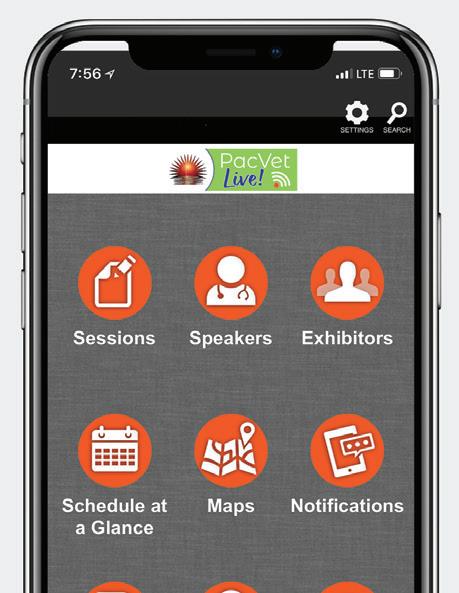
Attending PacVet Live without the PacVet app would be like having a barbeque without plates, going to the beach without a towel, or snorkeling without flippers. You get the idea.
The PacVet app unlocks the tools you will need to get the complete PacVet Live experience.
Use it to:

Plan your sessions
Participate in games with fun prizes
View speaker bios and course descriptions
Receive helpful push notifications

Make contact with exhibitors and view exhibitor show specials
Download the PacVet app at

Avian and Exotics – Track B
Reptiles
Friday, June 18
Avian Saturday, June 19
Equine – Track B
Radiology and Ultrasound Friday, June 18
Emergency and Critical Care Saturday, June 19
Practice Management – Track A
Dentistry/Practice Profitability Friday, June 18
Shelter Medicine – Track B
Anesthesia and Pain Management Sunday, June 27
Small Animal Medicine – Track A
Pharmacology
Ophthalmology
Friday, June 18
Saturday, June 19
Gastroenterology Saturday, June 26
Internal Medicine
Nephrology/Urology
Saturday, June 26
Sunday, June 27
Small Animal Surgery – Track A
Sports Medicine and Rehabilitation Saturday, June 19
Soft Tissue Sunday, June 27
Technician – Track B
Emergency and Critical Care Saturday, June 26
Pain Management Saturday, June 26
Behavior Sunday, June 27
Attending PacVet Live is as easy as a walk on the beach – even for the technologically challenged. PacVet Live staff will be available by phone to guide you through registration, logging into the conference, and moving between tracks. Before the conference, you’ll receive an invitation to try out the process of logging on with one of our staff members who can answer any questions you might have.





• Online: visit PacVet.net












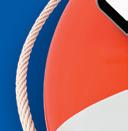






• Mail: Fill out the registration form on the next page and mail it with payment to Pacific Veterinary Conference, 1400 River Park Drive, Suite 150, Sacramento, CA 95815


• Fax: 916.646.9156
• Call: 800.655.2862 to register and pay with credit card
Early-bird registration is good through April 14, 2021. There is a $75 savings based on full conference registration

Do you feel like you are treading water when it comes to technology?
CVMA Member: m Yes m No
June 18-19, 2021
June 26-27, 2021
Do you want us to use this information to update your CVMA profile? m Yes m No
Please check one: m DVM m VMD m RVT m CVT m LVT m Practice Manager m Veterinary Staff m Other Attendee Name:
Phone (Required):
Email (Required):
Registration Deadline: June 11, 2021 (Registrations sent by mail must be received by June 11, 2021)
Enclosed is a check for $ Charge my VISA/MasterCard/Discover/AMEX $
CVMA Distinguished Life Members
Please call the CVMA office at 800.655.2862 for complimentary registration.
Mail registration form with payment to: CVMA, 1400 River Park Drive, Suite 100, Sacramento, CA 95815. You may also register by faxing the form to 916.646.9156, calling 800.655.2862 or register online at pacvet.net.
Full registration includes: Up to 32 CEUs, lecture notes, and a certificate of completion.
Conference/Login Information:
• Login information provided by the CVMA should not be shared with others; doing so may hinder your own access, as webinar is by pre-registration only. Attendance of PacVet Live is only for registered attendees.
By registering for PacVet Live 2021, I agree to the rules and regulations and the cancellation/ refund policy of this conference. For complete rules and regulations, visit PacVet.net.

All cancellation requests must be made in writing and submitted either by fax, email, or regular mail no later than May 21, 2021 to receive a full refund, less 10 percent administration fee. No refunds for cancellations or registrations received after this date. Refunds due will be paid within 45 days upon written cancellation request.
Attn: Meetings & Events Department 1400 River Park Drive, Suite 150 Sacramento, CA 95815
By fax: 916.646.9156
By email: info@pacvet.net
Any and all changes or substitutions after submission must be submitted in writing by either mail, fax, or email to above by June 11, 2021.
• Course materials provided by CVMA are for use by the registered attendee only and may not be reproduced or shared with others.
• Audio, documents, materials, chat, and Q&A exchanged or viewed during the session may be recorded. By joining a session, you automatically consent to such recordings.
• CVMA and its service provider of audio and online conferencing services are not responsible for unauthorized access to information by hackers or others that obtain access through illegal measures.
With few exceptions, a complete abdominal exploratory should be performed any time a laparotomy is performed. This allows the veterinarian to evaluate all abdominal organs visually and via palpation to ensure no previously undiagnosed abnormalities exist. Many surgeries will be performed based on the results of diagnostic imaging, but the surgeon must remember that imaging techniques can miss pathology that a thorough abdominal exploratory procedure may expose. Abdominal procedures may not warrant a full abdominal exploratory laparotomy if they are focused on correcting or diagnosing disease in a specific organ and there is little to no risk of the disease affecting other abdominal structures. Examples of abdominal procedures that may not warrant a complete abdominal exploratory include the following:
• Prophylactic gastropexy
• Ovariohysterectomy/ovariectomy on a healthy animal
• Cryptorchid castration on a healthy animal
• Cesarean section on an otherwise healthy animal

• Liver biopsies on an otherwise healthy animal with elevated ALT/AST and no imaging abnormalities
• Splenectomy for an animal with IMHA
• Cystotomy for urolith retrieval on an otherwise healthy animal
Technique: The goal of abdominal exploration is to use a consistent pattern to assess the entire abdominal cavity, with palpation or visualization of all structures. Each structure should be evaluated for size, color, texture, shape, and abnormalities. Different sequences of organ assessment are used. More important than the exact
sequence is the consistent use of a pattern to ensure that everything is evaluated! The following is a sample sequence used by the author
1. Place moistened laparotomy sponges to protect the incision then place a Balfour retractor.
2. Retract the sternum ventrally. Identify all liver lobes and gallbladder starting from left and working to right (Figure 1). Assess the dorsal and ventral aspects of each lobe. The caudate lobe is usually not visible at this point.
3. Identify the cardia of the stomach dorsal to the left lobes of liver and palpate the esophageal hiatus. Visualize the diaphragm
4. Follow the ventral surface of the stomach to right side and identify the fundus, body, and pylorus

5. Find the greater omentum, which attaches to the greater curvature of the stomach. Make an opening in the greater omentum just caudal to the stomach with your fingers to access the omental bursa. Within the bursa, identify the left lobe and body of pancreas, the dorsal aspect of the stomach and the papillary process of the caudate liver lobe
6. Return to the pylorus of the stomach and follow it aborad to the duodenum. Retract the duodenum and its mesentery (mesoduodenum) medially (towards the animal’s left side) and note the right limb of the pancreas, right kidney, right ureter, vena cava, portal vein, common hepatic artery, right ovary, and right uterine horn (or right testicular artery) (Figure 2)
7. Identify the right adrenal gland. This structure can be difficult to locate in dogs, but is usually palpable

dorsal to the vena cava just cranial to the right kidney.
8. Identify the epiploic foramen, bordered dorsally by the caudal vena cava and ventrally by the portal vein. You may see some pancreas from the lesser omental sac protruding through the epiploic foramen. You should be able to place a finger around the hepatic artery/portal vein/bile duct through the epiploic foramen.
9. Follow the duodenum aborally to the duodenocolic ligament (from duodenum to descending colon). By retracting the remaining intestines cranially, you can improve exposure in this area (Figure 3). Continue to follow the intestines aborally to the jejunum, ileum, and cecum (Alternately, if it is difficult to trace the duodenum aborad from the duodenocolic ligament, a loop of jejunum can be grasped and then followed both orad [to the duodenocolic ligament] and aborad [to the cecum]). Palpate all bowel with your fingers.
10. Note the mesenteric lymph nodes in the root of the mesentery and near the ileocecocolic junction.
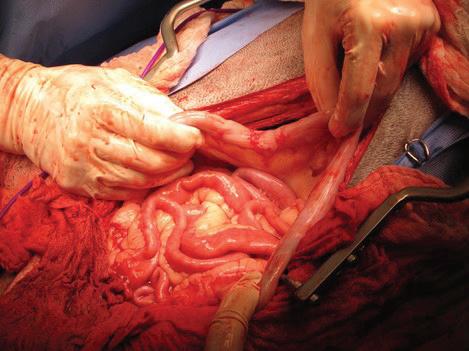
11. Identify the ascending, transverse, and descending colon. Pulling the rest of the intestines caudally can help improve exposure (Figure 4). The colon and its mesentery make a “bowl” for the small bowel. The descending colon is the retractor for the dog’s left side (as the descending duodenum is for the dog’s right side).
12. Retract the colon and mesocolon to the right and note the spleen, left kidney, left ovary and left uterine horn (or left testicular artery), left adrenal gland (with ventrally overlying phrenicoabdominal vein), and left ureter. For complete visualization, the spleen may also need to be retracted to the right.
13. Inspect the lateral and hilar surfaces of the spleen and follow the gastrosplenic ligament and short gastric vessels from the spleen to the stomach
14. Identify the bladder, with its lateral and ventral ligaments. Note where the ureter/blood/nerves
enter the bladder on the dorsal surface (Figure 5). Note the vas deferens/prostate (if present). Evaluate the uterine body and cervix (if present).
15. Return the viscera to the abdomen and remove the Balfour. If the intestines are pink, they are OK. If not, evaluate the mesentery to ensure that it did not become twisted during bowel manipulation. The colon should be put in place first to ensure that the cecum is on the animal’s right side and the descending colon on the left. The jejunum can sit in the ‘bowl’ formed by the colon.


 By
Grant Miller, DVM, CVMA Director of Regulatory Affairs
By
Grant Miller, DVM, CVMA Director of Regulatory Affairs
Veterinary students often spend time in private veterinary practices as part of a distributive formal curriculum, through employment, or by volunteering. The law draws distinctions as to what veterinary tasks students are permitted to perform on patients in private practices. This article will categorize these distinctions and the laws that apply to each.
Category One: First or second-year students from AVMA-accredited veterinary schools or students from non-AVMA accredited veterinary schools
This most restrictive category applies to first and second-year students from schools accredited by the American Veterinary Medical Association (AVMA) and to all students from non-AVMA accredited schools. These students are considered to be veterinary assistants and are able to perform auxiliary health care tasks pursuant to California Code of Regulations, title 16 (CCR 16), section 2036.5. The degree of supervision over these students may be either direct or indirect when they are performing auxiliary health care tasks, but may never be less than the degree of supervision attending to a registered veterinary technician (RVT) performing the same tasks in the practice. The law also allows veterinary assistants who possess a Veterinary Assistant Controlled Substance Permit, and therefore students with the same, to administer controlled substances under the direct or indirect supervision of a supervising veterinarian. Students in this category are not allowed to perform tasks reserved for RVTs, as described in Category Two below.
Category Two: Third or fourth-year veterinary students from AVMA-accredited schools employed or volunteering at a private practice
For veterinary students who are participating at a private practice outside of a school-approved externship or formal curriculum, CCR 16, section 2027 states that a junior (third-year) or senior (fourth-year) student from an AVMA-accredited school may perform job tasks reserved for RVTs provided that the degree of veterinary supervision over the student is identical to that specified for RVTs. “RVT job tasks” are listed in CCR 16, section 2036 and include performing the following under direct veterinary supervision: inducing anesthesia; applying casts and splints; performing dental extractions; suturing
cutaneous, subcutaneous, gingival, or oral mucous membrane tissues; and creating a relief hole in the skin to facilitate placement of an intravenous catheter. Those tasks also include the administration of controlled substances under indirect veterinary supervision. They exclude, however, surgery, diagnosing, and prescribing. Those exclusions would therefore also apply to third or fourth-year students in this scenario pursuant to CCR 16, section 2027.
Category Three: Students from AVMA-accredited schools in approved externships or clinical rotations as part of a formal curriculum
To gain practical experience, veterinary students at the end of their third year will complete 12 months of “clinical rotations,” usually in their school’s veterinary hospital and at private veterinary practices. If a student is participating at a private practice as part of a formal curriculum (such as during a school-approved externship or as part of a distributive teaching model), California
Business and Professions Code section 4830(a)(4) applies. That provision states that veterinary licensure is not required for the following:
A student of a veterinary medical program accredited by the American Veterinary Medical Association Council on Education who participates as part of his or her formal curriculum in the diagnosis and treatment with direct supervision, or in surgery with immediate supervision, provided all of the following requirements are met:
(A) The clinical training site has been approved by the university where the student is enrolled.
(B) The student has prior training in diagnosis, treatment, and surgery as part of the formal curriculum.
(C) The student is being supervised by a Californialicensed veterinarian in good standing.
Students in this scenario may also perform the auxiliary health care functions and RVT functions listed in Categories One and Two, respectively, and therefore are given greater latitude to hone their veterinary skills before becoming licensed veterinarians.

Knowing which type of student is coming to the practice is important to determine what the student may do while at the practice. Understanding the applicable laws in each category will ensure compliance and reduce the chance of issues arising during this important stage of the student’s educational experience.
This article is for informational and general educational purposes only. It is not intended to take the place of legal advice nor should it be considered as a legal interpretation. Although significant effort has been made to ensure the accuracy and completeness of the information at the time of publication, the CVMA shall not be responsible for any errors or omissions, or any agency’s interpretation, application, or enforcement of the information presented herein.
THE CVMA CAN ASSIST YOU WITH ALL OF YOUR REGULATORY COMPLIANCE NEEDS . VISIT CVMA.NET/PRODUCTS.

Businesses can incur heavy fines for not posting the proper notices in the workplace. The CVMA offers this updated employee posting consisting of two laminated posters.

• Cal/OSHA – Safety and Health Protection
• State and Federal Minimum Wage
• Pay Day Notice
• DFEH Pregnancy Disability Leave Notice
• Wage Order #5
• Paid Sick Leave Notice
• Family Medical Leave Act
• Time O : Voting, Child Care, School Events
• Workers’ Compensation Notice/If You Get Hurt
• Access to Medical and Exposure Records

• Polygraph Protections
• Equal Employment Opportunity/GINA/USERRA
• EDD – Unemployment/Disability Insurance
• Harassment or Discrimination Notice
• Whistleblower Protection
• National Labor Relations Act Rules for Employees
• Employee Special Notices
Local Ordinances require special postings for practices in select cities. Contact the CVMA for more information at 800.655.2862 or sta @cvma.net.
The CVMA offers a series of 8¾” x 11¾” laminated plaques that are suitable for hanging in your practice and meet a number of regulatory requirements.

Required Postings
• Proposition 65 Warning (for practices with more than 10 employees)
• Continuous Presence Not Provided (required if animals will be left on the premises for any period of time without someone present)
• California Abandoned Animal Act (if you hospitalize/board animals)
• Financial Interest Disclosure (if applicable)
• Written Prescriptions (gives clients written notification that they have the right to receive a written prescription)
Not Required but Recommended
• Prescription Drug Dispensing (helpful in explaining restrictions to clients)
The Radiation Compliance Kit is custom-designed to fulfill all of the regulatory requirements for veterinary practices. It includes required postings, the “Caution X-Ray” sign, radiation safety training materials, and detailed instructions on how to implement a radiation compliance program.

Various regulatory agencies require that every employee be given several pamphlets at the time of hire. It is recommended that employers provide the pamphlets to all current employees if they did not receive them at the time of hire.
Purchase your CVMA Guide to Cal/OSHA Compliance subscription today!
The CVMA Guide to Cal/OSHA Compliance is an online tool created specifically to help California veterinary practices with Cal/OSHA compliance. It includes educational materials, required forms, training templates, implementation and recordkeeping resources, and a step-by-step wizard that simplifies the process of creating a customized written safety plan for your practice. Each section has clear instructions and a logical progression which results in a safety program catered to each individual subscriber.
The California Department of Industrial Relations Division of Occupational Safety and Health (Cal/ OSHA) has implemented emergency COVID-19 workplace prevention regulations which require California businesses to immediately implement extensive new workplace safety and health measures. They include a written COVID-19 Protection Program policy as part of the Injury and Illness Prevention Program (IIPP). The CVMA Guide to Cal/OSHA Compliance has recently been updated to include the required COVID-19 component.
The CVMA Guide to Cal/OSHA Compliance is available only to CVMA members. The online subscription-only guide can be accessed and updated at anytime.
For more information or to renew your subscription visit cvma-inline.net/regulatory-guide, call the CVMA at 800.655.2862 or email sta @cvma.net.
4 EASY WAYS TO ORDER
• CVMA.NET shop online – cvma.net/products.
• CALL 800.655.2862 M–F between the hours of 8:30 AM and 5:00 PM.
• FAX completed form found at cvma.net/order-form to 916.646.9156.
• MAIL completed form found at cvma.net/order-form to 1400 River Park Dr., Ste. 100, Sacramento, CA 95815.
The CVMA Guide to Cal/OSHA Compliance $279.00 Online only (no shipping fee or sales tax)
Renewal Rate
(prior to subscription expiration)
Ordinances (required for select cities) $18.00 $23.00 Call the CVMA office for more information.
• Prop. 65 Warning for Employees (CalEPA requirement)
• Continuous Presence Not Provided (VMB requirement)

• California Abandoned Animal Act (VMB requirement)
• Prescription Drug Dispensing – Prior exam required
• Written Prescriptions (VMB requirement)
Please allow up to 10 business days for the CVMA Guide to Cal/OSHA Compliance order to be processed. You will then be able to view the guide online by clicking on the CVMA Guide to Cal/ OSHA Compliance link from the CVMA website home page after you log in. Please allow up to three weeks to receive the Employee Posting set, New Hire packets, plaques, and Radiation Compliance Kits. All returned items are subject to a 15% restocking fee. Shipping charges on returns are the customer’s responsibility. Credit will be issued only for returned items in original condition within 30 days.
On January 27-29, 2021, the CVMA attended meetings of the California Veterinary Medical Board (VMB) and its Multidisciplinary Advisory Committee (MDC). At those meetings, CVMA Executive Director Dan Baxter, CVMA Director of Regulatory Affairs Dr. Grant Miller, and CVMA VMB Liaison Dr. Ken Pawlowski represented the profession on several issues.
The MDC voted to recommend statutory amendments to provide a pathway to licensure for foreign veterinary technology and nursing graduates. If passed, this legislation will be enacted in January of 2022.
The MDC subcommittee assigned to research telemedicine recommended that current California telemedicine law be maintained. The subcommittee did recommend that the VMB develop guidance on what can be currently done using telemedicine within current regulations and to better define telemedicine-related terms.
After receiving public comments expressing concern over the significant RVT licensing fee increases in 2020, the MDC voted to present a fee adjustment package to the VMB with recommended changes that included an RVT fee reduction.
The VMB voted to withdraw a rulemaking package relating to duties of supervising veterinarians because it did not feel that the proposed changes to the package improved consumer protection, the VMB’s primary mandate.
In relation to the MDC’s telemedicine recommendations discussed above, the VMB directed the MDC to research telemedicine-related definitions.
Maria Salazar-Sperber was appointed as a public member to the MDC to replace resigning member Stuart Eckmann.
The VMB passed a motion to eliminate the California State Licensing Exam for veterinarians. This will require several statutory and regulatory changes, and will
be taken up by the state legislature this year. If this legislative and regulatory package passes, veterinarians will not have to take a state licensing examination as part of California licensure; however, other requirements will need to be satisfied.
Following a presentation about systemic poverty and issues of underserved populations accessing veterinary care, the VMB voted to form a committee to explore access to care issues and how the VMB, through its legal authority, can address these concerns.
The VMB voted to advance the following regulations in the rulemaking process:
• Animal Physical Rehabilitation The proposed regulations will now move to the Department of Consumer Affairs (DCA) Director for approval before being submitted to DCA legal counsel for review.
• VMB Disciplinary Guidelines Changes were adopted relating to probation monitoring. The proposed changes to the Disciplinary Guidelines will be opened to public comment for 15 days.
• Emergency Fee Increase The VMB discussed the numerous public comments received pertaining to emergency fee increase regulations that were instituted in January of 2021 and noted that measures were being taken to help remedy the disproportionate fee increase for RVTs.
• Veterinary Drug Compounding VMB staff analyzed public comments received and the Board voted not to amend the proposed regulations any further prior to moving them forward in the rulemaking process.
The VMB voted to pass a motion to ask the DCA Director to extend current COVID telemedicine and prescription refill extension waivers until either the end of the declared state of emergency or until the MDC reaches a conclusion about the issue. Currently, those waivers are in place through June, 2021, but they may be extended further depending on the decision of the DCA Director.
Every year the California Department of Food and Agriculture (CDFA) updates the list of reportable conditions for animals and animal products in an effort to keep California safe from foreign animal diseases, diseases with zoonotic potential, and diseases that could have an adverse economic impact on our agriculture and trading businesses.
California veterinarians play a major role in this mission, and timely disease recognition and reporting is a vital component of surveillance and disease control. Early recognition and reporting are essential to enable animal health officials to respond quickly to diseases that can seriously impact animal health and the agriculture industry. Routine monitoring is crucial to identifying both changes in disease patterns and high-risk areas and groups in California. The CDFA depends on partnering with veterinarians like you, who watch for and notify our agency of reportable diseases in animals.
The CDFA’s highest priority is to keep California safe from foreign animal diseases. One of the major achievements in 2020 of the CDFA’s Animal Health Branch (AHB)—in cooperation with many other agencies such as the United States Department of Agriculture (USDA) Animal and Plant Health Inspection Service (APHIS), Veterinary Service (VS)— was the eradication of virulent Newcastle Disease (vND) after two years of fighting this devastating poultry disease. In that regard, the AHB district offices are constantly investigating diseases and disease outbreaks in agricultural animals as well as poultry. All in all, over 820 foreign animal disease (FAD) investigations were completed by CDFA staff in 2020. The majority of these disease investigations were performed to rule out foot and mouth disease (FMD).
Two major changes have occurred since the last reportable disease update. First, due to its endemic distribution, Rabbit Hemorrhagic Disease has been moved from emergency to regulated conditions. Second, due to increased reports of severe acute respiratory syndrome Coronavirus 2 (SARSCoV-2) in animals such as minks, dogs, cats, tigers, lions, gorillas, and whitetail deer, and the potential risk of human infections from those animals, novel coronavirus has been added to the multispecies emergency disease list. Veterinary practices, laboratories, and individuals who are aware of a presumptive or confirmed diagnosis of SARS-CoV-2 in an animal that resides in or potentially became infected in California are required to report those test results to CDFA within twenty-four (24) hours of discovery.
Some private laboratories offer SARS-CoV-2 testing on animal samples - testing by these laboratories does not require state approval. However, animals that test positive should have results confirmed by USDA’s National Veterinary Services Laboratory (NVSL), the only official testing laboratory for SARS-CoV-2 in animals in the US. Official testing of animals at NVSL is strictly controlled and may be pursued only with the approval of state animal health and public health officials. Veterinarians must contact CDFA.AHFSS_COVID19_Animal_Testing@cdfa.ca.gov to coordinate confirmatory testing. In any case, it is important to note that routine testing of animals for SARS-CoV-2 is not recommended; the California Department of Public Health has testing guidance for veterinarians on their website (https://www.cdph.ca.gov/Programs/CID/DCDC/Pages/ COVID-19/SARSCoV2(causativeagentforhumanCoVID19) TestinginAnimals.aspx).
Please remember that California law requires that any licensed veterinarian, any person operating a diagnostic laboratory, or any person who has been informed, recognizes, or should recognize by virtue of education, experience, or occupation, that an animal or animal product is or may be affected by, has been exposed to, or may be transmitting or carrying any of the conditions listed, must report that information to CDFA or the United States Department of Agriculture (USDA).
Immediately report any animal disease not known to exist in the United States, any event with increased mortality and/or morbidity of unknown cause or source, and any toxicology condition likely to contaminate animals or animal products (meat, milk, or eggs). Call if you see vesicles, unusual or unexplained illness, CNS signs, mucosal diseases, hemorrhagic septicemias, unusual larvae in wounds, uncommon ticks, or high morbidity or mortality.
Call the Department of Food and Agriculture, Animal Health Branch (AHB) District o ces to report:
Redding: 530.225.2140
Modesto: 209.491.9350
Tulare: 559.685.3500
Ontario: 909.947.5932
AHB Headquarters: 916.900.5002 or the USDA, APHIS, Veterinary Services (VS) o ce at 1.877.741.3690
*Pursuant to Section 9101 of the California Food and Agricultural Code, Title 3 California Code of Regulations § 797 and Title 9 Code of Federal Regulations Section 161.4(f)

WHO MUST REPORT: Any licensed veterinarian, any person operating a diagnostic laboratory, or any person who has been informed, recognizes or should recognize by virtue of education, experience, or occupation, that any animal or animal product is or may be affected by, or has been exposed to, or may be transmitting or carrying any of the following conditions, must report that information.
WHAT TO REPORT: Immediately report any animal disease not known to exist in the United States, any event with increased mortality and/or morbidity of unknown cause or source and any toxicology condition likely to contaminate animals or animal products (meat, milk or eggs).
CALL IF YOU SEE: high morbidity or mortality, vesicles, CNS signs, uncommon ticks, hemorrhagic septicemias, unusual larvae in wounds, unusual or unexplained illness
Report any emergency, regulatory, or monitored condition within the provided time frame. Some diseases are listed under the major species of concern; if you see compatible signs for such conditions in another species, please report!
Redding 530-225-2140, Modesto 209-491-9350, Tulare 559-685-3500, Ontario 909-947-5932, Headquarters 916-900-5002, or VS at 1-877-741-3690
General, non-specific conditions: Unexplained high mortality or diseased animals; livestock exposed to toxic substances.
• Anthrax (Bacillus anthracis)1
• Crimean Congo hemorrhagic fever1
• Foot-and-mouth disease
• Heartwater (Ehrlichia ruminantium)
• Japanese encephalitis
• Melioidosis (Burkholderia pseudomallei)
• Rabies of livestock1
• Rift Valley fever
• Severe acute respiratory syndrome Coronavirus-2 (SARS-CoV-2)1
• Screwworm myiasis (Cochliomyia hominivorax or Chrysomya bezziana)
• Surra (Trypanosoma evansi)
• Vesicular stomatitis
BOVINE
• African trypanosomiasis (Tsetse fly diseases)
• Bovine babesiosis (Cattle tick fever)
• Bovine spongiform encephalopathy
• Contagious bovine pleuropneumonia (Mycoplasma mycoides mycoides small colony)
• Foot-and-mouth disease
• Hemorrhagic septicemia (Pasteurella multocida B/Asian or E/African)
• Lumpy skin disease
• Malignant catarrhal fever (wildebeest-associated form)
• Rinderpest
• Schmallenberg virus / Akabane
• Theileriosis (Theilera parva parva or T. annulata)
CAPRINE/OVINE
• Contagious caprine pleuropneumonia (Mycoplasma capricolum capripneumoniae)
• Foot-and-mouth disease
• Nairobi sheep disease
• Peste des petits ruminants (Goat plague)
• Schmallenberg virus / Akabane
• Sheep pox and goat pox
PORCINE
• African swine fever
• Classical swine fever
• Foot-and-mouth disease
• Nipah virus encephalitis
• Swine vesicular disease
AVIAN SPECIES
• Avian influenza (HPAI and H5/H7 LPAI)
• Turkey rhinotracheitis (Avian metapneumovirus)
• Virulent Newcastle disease (Exotic Newcastle disease, velogenic viscerotropic Newcastle disease)
EQUINE
• African horse sickness
• Dourine (Trypanosoma equiperdum)
• Glanders (Farcy; Burkholderia mallei)
• Hendra virus (Equine morbillivirus)
• Venezuelan equine encephalomyelitis
• Vesicular stomatitis
CERVIDS/LAGOMORPHS/CAMELIDS
• Middle East respiratory syndrome coronavirus (MERS-CoV)
1 Diseases in green, seen in any species, are also reportable to California Department of Public Health (CDPH)
For additional information, contact CDFA (email: cavet@cdfa.ca.gov or visit our website at www.cdfa.ca.gov/ah)
MULTIPLE SPECIES
• Brucellosis (B. melitensis, B. abortus, B. suis)1
• Pseudorabies (Aujeszky’s disease)
• Tuberculosis (Mycobacterium bovis)1
• Tularemia1
BOVINE
• Bovine brucellosis (Brucella abortus)1
• Bovine tuberculosis (Mycobacterium bovis)1
• Trichomonosis (Tritrichomonas foetus)
CAPRINE/OVINE
• Caprine and ovine brucellosis (Brucella melitensis)1
• Scrapie
• Sheep scabies (Body mange; Psoroptes ovis)
PORCINE
• Porcine brucellosis (Brucella suis)1
• Pseudorabies (Aujeszky’s disease)
AVIAN SPECIES
• Fowl typhoid (Salmonella gallinarum)
• Ornithosis (Psittacosis, avian chlamydiosis; Chlamydia psittaci)
• Pullorum disease (Salmonella pullorum)
EQUINE
• Contagious equine metritis (Taylorella equigenitalis)
• Eastern equine encephalomyelitis
• Epizootic lymphangitis
• Equine herpesvirus myeloencephalopathy (EHM)
• Equine infectious anemia
• Equine piroplasmosis (Babesia caballi or Theileria equi)
• Western equine encephalomyelitis
• West Nile virus
CERVIDS/LAGOMORPHS/CAMELIDS
• Chronic wasting disease
• Rabbit hemorrhagic disease (Calicivirus)
MULTIPLE SPECIES
• Bluetongue
• Echinococcosis/hydatidosis (Echinococcus species)
• Epizootic hemorrhagic disease
• Johne’s disease (Paratuberculosis; Mycobacterium avium paratuberculosis)
• Leishmaniosis
• Q Fever (Coxiella burnetii)
BOVINE
• Anaplasmosis (Anaplasma marginale or A. centrale)
• Bovine cysticercosis (Taenia saginata)
• Bovine genital campylobacteriosis (Campylobacter fetus venerealis)
• Bovine viral diarrhea
• Enzootic bovine leukosis (Bovine leukemia virus)
• Infectious bovine rhinotracheitis (Bovine herpesvirus-1)
• Malignant catarrhal fever (sheep-associated form)
CAPRINE/OVINE
• Caprine arthritis/encephalitis
• Contagious agalactia (Mycoplasma agalactiae, M. capricolum subsp. capricolum, M. mycoides subsp. capri, M. putrefaciens)
• Enzootic abortion of ewes (Ovine chlamydiosis; Chlamydia abortus)
• Maedi-visna (Ovine progressive pneumonia)
• Ovine epididymitis (Brucella ovis)
• Salmonella abortusovis
REPORT
WHERE TO REPORT: Department of Food and
PORCINE
• Porcine cysticercosis (Taenia solium)
• Porcine reproductive and respiratory syndrome
• Senecavirus A
• Swine enteric coronavirus diseases, including transmissible gastroenteritis
• Swine influenza
• Trichinellosis (Trichinella spiralis)
AVIAN SPECIES
• Avian infectious bronchitis
• Avian infectious laryngotracheitis
• Duck viral hepatitis
• Goose parvovirus
• Infectious bursal disease (Gumboro disease)
• Influenza A viruses (see Emergency Conditions for HPAI and H5/H7 LPAI)
• Mycoplasmosis (Mycoplasma synoviae and Mycoplasma gallisepticum)
EQUINE
• Equine herpesvirus-1 and 4 (excluding EHM)
• Equine influenza
• Equine viral arteritis
CERVIDS/LAGOMORPHS/CAMELIDS
• Camelpox
• Myxomatosis
1-877-741-3690
Agriculture, Animal Health Branch (AHB) District Office: Redding 530-225-2140, Modesto 209-491-9350, Tulare 559-685-3500, Ontario 909-947-5932; AHB Headquarters at 1220 N Street, Sacramento, California 95814, telephone 916-900-5002, facsimile 916-900-5333; or the USDA, APHIS, Veterinary Services (VS) office at1 Diseases in green, seen in any species, are also reportable to California Department of Public Health (CDPH)
FISH, AMPHIBIAN, CRUSTACEAN, BEE, AND MOLLUSK DISEASES listed by the OIE: https://www.oie.int/animal-health-in-the-world/oie-listed-diseases-2020/
The Mary Jo and Hank Greenberg Animal Welfare Foundation has awarded $300,000 to the Western University of Health Sciences College of Veterinary Medicine to replace its aging Veterinary Ambulatory Community Support Vehicle (VACS 1).

Matt Zarcufsky, president of the Foundation, said of the gift, “The directors of the Foundation could not be any more thrilled with our investment in WesternU’s College of Veterinary Medicine. It’s really a win for everyone: the College of Veterinary Medicine, the world-class veterinarians it is training, but most importantly the animals and their humans in the communities they serve are the biggest winners. Mary Jo would be extremely proud.”
CVM Dean Phillip Nelson, DVM, PhD, said the gift would be put to important use.
“The timing could not be more opportune, and the recognition of WesternU’s efforts more gratifying. We greatly appreciate the Mary Jo and Hank Greenberg Animal Welfare Foundation’s contribution,” said Dr. Nelson. “The student experiences provided by the vehicle, combined with the direct care for animals, make this a gift that will pay off for the community many times over.”
The VACS program is a service-learning initiative, offering basic veterinary care to underserved animal populations and the people who care for them. It promotes veterinary student learning about medicine, societal issues, and community service through active civic engagement and outreach. VACS is dedicated to increasing successful petfamily relationships and reducing homeless animal populations through education and care.
Students are able to work in the mobile VACS van, a fully equipped clinic-on-wheels. The van often travels to health fair events, where students and faculty provide physical examinations, spay and neuter and other services. Students begin their work on the VACS van as early as their first year at WesternU.
The grant from the Mary Jo and Hank Greenberg Animal Welfare Foundation will ensure that the university will continue to provide those vital services to the Southern California community.
“This investment is a testament to our commitment to our students and local communities, as well as to the value of that commitment to their future,” Dr. Nelson added.
WesternU launched its VACS program in 2004 with the VACS 1 van. A second, more modern vehicle was added to the program in 2013. The new vehicle will replace VACS 1.
The Mary Jo and Hank Greenberg Animal Welfare Foundation, headquartered in Beverly Hills, serves organizations that rescue and provide care, housing, and services for neglected animals—primarily cats and dogs. The private nonprofit foundation was created in 1999 by the late film actress Mary Jo Greenberg in her name and that of her husband, Hank Greenberg, a major league baseball player in the 1930s and 1940s and a member of the National Baseball Hall of Fame. A first baseman and left fielder, Greenberg was a two-time league Most Valuable Player with the Detroit Tigers.
The Western University of Health Sciences’ School of Veterinary Medicine deploys its Veterinary Ambulatory Community Support Vehicles (VACS) to support the surrounding communities. Thanks to a new grant from the Mary Jo and Hank Greenberg Foundation, a new vehicle will soon join the VACS 2 van (pictured).
The veterinary field is becoming more competitive, which makes it essential for veterinary professionals to be versed in business and entrepreneurship. Fortunately, this year UC Davis is making its business and entrepreneurship programs even more accessible by taking them entirely online.
The Foundations of Veterinary Business program— designed for practice owners, prospective owners, practice leaders, and hospital administrators—runs from May 15 to August 14, with both self-paced online learning modules and live Zoom course elements. The National Veterinary Entrepreneurship Academy is targeted to researchers and product developers who wish to commercialize their work and runs in entirely live Zoom sessions from July 12-16. Both programs combine the veterinary expertise of the nation’s number one veterinary school with the business expertise of the nationally ranked UC Davis Graduate School of Management.
As the challenges of starting, purchasing, or growing a veterinary practice have increased, more members of the veterinary profession are seeking formal business training to foster their success.
The Foundations of Veterinary Business certificate program launched in 2019 with a sold-out course that featured topics including managerial accounting, finance, marketing, strategy, human resources, operations and much more. This year’s program includes the same popular topics hosted in a mix of live, interactive Zoom sessions and self-paced online learning covering both general “business basics” and key veterinary-specific business information.
“The pandemic and its restrictions on in-person learning made us rethink our approach to this course,” said Program Coordinator Jim Clark, DVM, MBA. “Our revised format will retain the best aspects of our pilot program, but be more convenient and cost effective.”
Sessions are taught by UC Davis Graduate School of Management faculty and veterinary industry experts
who present analyses of real-world veterinary business scenarios. Three live Zoom Saturday sessions reinforce learning from the online coursework and encourage collaboration. Participants will work in teams to analyze veterinary businesses and present at the final meeting.
Upon successful completion of the program, graduates will receive a certificate from the UC Davis Graduate School of Management. Participants will have continued access to course materials for future reference. Registration is $2,500 and limited to 50 participants. The registration deadline is May 1, however the program will fill on a first-come, first-served basis. Fifteen slots are reserved for veterinary students with a strong interest in veterinary business. More information can be found at gsm.ucdavis.edu/post/ foundations-veterinary-business.
The National Veterinary Entrepreneurship Academy helps researchers, faculty, postdocs and students in veterinary medicine and science gain the knowledge and networks to identify, develop, and validate the commercial potential of their research or idea.
The academy is presented by the UC Davis School of Veterinary Medicine, a global leader in veterinary research, and the Mike and Renee Child Institute for Innovation and Entrepreneurship, which is part of the Graduate School of Management. The academy leverages the university’s more than 10 years of experience presenting programs for the greater UC Davis community.
Participants will frame and explore the market prospects of their ideas; participate in workshops to address technical, business, and market validation; attend seminars and panels led by UC Davis faculty and leading investors, industry executives, and entrepreneurs; learn tools to help communicate the broader potential of their research; and work with mentors to focus their approach and hone their pitch.
The academy takes place from July 12-16 and costs
$1,500. Participants receive a certificate. More information can be found at gsm.ucdavis.edu/nvea.
The COVID-19 pandemic has created profound challenges for veterinary educators and students alike. The CVMA Board of Governors’ student representatives, Megan Dietz and Christopher Morrill provide insight into learning during a pandemic.
This past year, COVID-19 entered our lives, ushering in a new normal of isolation, protective masks, and workplace policies for keeping ourselves, our family, and our friends safe. UC Davis School of Veterinary Medicine is no exception and students and faculty have adopted many virtual and in-person changes to keep our education going. Mask requirements make PPE not just a mainstay of our ongoing spay-and-neuter and food animal labs, but our daily campus interactions. Students have become experts on sensitivity and specificity to pass our population medicine finals and appreciate our weekly required COVID testing. Zoom lectures on FIP in cats and IBV in chickens peak our interest a little more this semester.
Amid COVID, many of our day-to-day activities have moved online, including all lectures, videomonitored examinations, and clinical skills labs with “lab-to-go” kits including catheterization models, surgery packs, and suture pads. But through careful symptom screening, daily temperature checks, and maintenance of assigned lab groups, we have safely continued important microscopy, anatomy, and surgery labs, and our fourth-year students have maintained their clinical rotations.
This is not to say things are easy—students and faculty face fatigue, depression, and grief over the loss of normalcy and even colleagues, friends, or family to this terrible virus. But, at the same time, we have adapted together to support our veterinary community. This unprecedented pandemic has added new lessons in resiliency to our curriculum, and reaffirmed our ability to face whatever challenges may come as we follow our dream of becoming veterinarians.
by Christopher Morrill, WesternU College of Veterinary Medicine Class of 2022Despite the SARS-CoV-2 pandemic, education at WesternU has continued to provide a valuable foundation for future graduates. Students and teachers alike are striving to make the most of our predominantly virtual curriculum.
While each class year has had its obstacles to overcome, the incoming class of 2024 has been particularly resilient. They began their veterinary education with virtual problem-based learning sessions. While the online aspect has posed challenges, students have reported that these struggles have actually fostered strong friendships among classmates.
Like our first year students, a major obstacle for the members of the class of 2023 has been their inability to perform in-person clinical skills labs. Our curriculum is aimed at providing many early, hands-on experiences to prepare students for clinical rotations in their third year. Despite this, many online lectures are in place to accommodate student learning and promote an easier transition into clinical settings.
As for the class of 2022, most students are enduring a reduction in their clinical hours with online lectures as replacements. While this year of the curriculum is normally aimed at giving a breadth of clinical experience, many students remain confident in their abilities to prepare for the NAVLE and beyond.
Finally, the class of 2021 got off to a rocky start. Many clinical rotations were canceled or replaced with online substitutes. However, by the end of the semester, almost all students were able to return to a normal, in-person schedule while maintaining COVID-related safety protocols. Many have already received their passing NAVLE scores and are excited to graduate this year.
I believe that it is important to acknowledge the many obstacles that COVID-19 has imposed upon WesternU students and faculty. However, rather than causing frustration, these obstacles have instead denoted the resilience of our community and the versatility of our curriculum. Safety has been the unquestionable, number one priority and, despite our struggles, we are enduring the pandemic together while fostering a strong and dynamic education. It’s something that we should all be proud of.
Place your ad in the Career Center at cvma.net. There are two options for classified advertising:
1. Online advertising
2. Online and in one issue of the California Veterinarian
CVMA Members NonMembers
*Price includes the first six lines of text. Each additional line is $10/$11 for non-members. A line consists of approximately 50 characters.
**If you wish to place a print ad only, contact Laura Phillips at 916.649.0599 or classifieds@cvma.net.
Online only
30 days online
$149 $199
60 days online $249 $299
90 days online $349 $399
Online and in one issue of the California Veterinarian
60 days online + one issue of the California Veterinarian $299 $349
90 days online + one issue of the California Veterinarian $399 $449
POST AN ANONYMOUS AD OR RESUME
Resume – Post a confidential resume. Go to cvma.net. Click on the Resources tab then Classifieds in the right menu to get started.
Ad – Place a confidential ad by creating an anonymous email address and using it when posting your ad.
We are seeking a full time confident, determined associate veterinarian. Recent Grads Welcome, to join our growing practice in northern California. We are committed to high quality patient care and seeking applicants that are equally motivated. We are a cat friendly practice with feline only exam rooms, lobby and treatment areas. Candidate should be skilled clinician with surgery and dentistry experience as well as a high level of empathy and confidence for working in the field of feline veterinary care. Schedule: Weekdays 5 shifts 9am-6pm. Benefits include: Medical and CE Allowance. Salary: DOE, Competitive Base Salary plus commission pay structure. Should you feel you meet the outlined qualifications, you may submit your resume via email to chris@webvets.com.
Tri-City Veterinary Hospital is now hiring. We are seeking a full or part-time Veterinarian to join our growing veterinary hospital. About Us: We are a 34 year-old veterinary hospital in Fremont and part of the larger Bay Area. We are one of the largest providers of veterinary services in the Tri-City area of Fremont, Newark, and Union City and have varied medicine and surgical cases. We are locally owned and operated and have been independent since 1986. Our director Dr. Raj Salwan is a second-generation veterinarian and has mentored many veterinarians in the Bay Area, many of whom now own
If you have any questions, please contact customer service at 860.437.5700, clientserv@yourmembership.com, or classifieds@cvma.net.
DEADLINE DATES FOR AD SUBMISSIONS IN THE CALIFORNIA VETERINARIAN:
Issue
Jan/Feb
March/April
May/June
July/Aug
Sept/Oct
Nov/Dec
Deadline
December 5
February 5
April 5
June 5
August 5
October 5
If your ad is received after the deadline, it will go into the following month’s California Veterinarian. After the deadline, the CVMA cannot alter or cancel ads. The CVMA reserves the right to edit copy and does not assume liability for contents of classified advertising. Prices subject to change without notice.
their own practices. What we are looking for: We are looking for a team player who does their best to help each client, build good relationships, communicates well, and is responsible in their actions. Experience is a plus but new/newer graduates will certainly be considered. Although we do a variety of surgical procedures, don’t get discouraged in applying if you have no experience or interest in surgery - we could also use a good vet for rooms who has a different interest. Competitive Pay: $150,000 to $200,000 plus production. Email tricityjobopenings@gmail.com.
VCA PetCare East is hiring! We have openings for both GP and ER positions! PetCare is a large, progressive, 24-hour hospital in beautiful Santa Rosa. Our hospital includes general practitioners, emergency practitioners, and specialists. We are searching for someone who can integrate into a collaborative hospital that provides the highest quality of medicine. We have a family atmosphere and strive to have fun while doing exceptional veterinary care! The hospital itself is state-of-the-art; equipped with endoscopic and laparoscopic capabilities, a brand new GE ultrasound, and a 64-slice CT. You would be joining an amazing team that includes an Internist, 3 surgeons, an oncologist, and experienced general practitioners and emergency clinicians. Full benefits include: vacation, generous CE allowance, health insurance, dental insurance, disability, and vision insurance. Our hospital is a leading hospital for all of Sonoma County. We are located in the middle of wine country, a half hour from gorgeous beaches and redwoods. Come to a place where you can grow as a veterinarian and enjoy the amazing outdoors! Email Kimberly.Henry@vca.com.
Camden Pet Hospital is seeking an enthusiastic experienced veterinarian to lead our team of doctors as Chief of Staff. We are an established multi doctor practice that is well- equipped for all your medical and surgical needs. We are an AAHA Accredited Hospital and providing outstanding service to our clients and pets in the community is our top priority. Our doctors enjoy practicing in a facility equipped with advanced diagnostic features, including digital x-rays, an in-house lab, and therapeutic laser therapy, just to name a few. The caring and experienced team maintains an efficient and enjoyable work environment by being proactive to the needs of our doctors, patients, and clients. The Chief of Staff is responsible for monitoring the continued health of the practice by fostering an environment of teamwork in which quality medicine is delivered, and ensuring that outstanding customer service is a top priority. This is a perfect opportunity for an experienced veterinarian, with strong surgery and dentistry skills, interested in a leadership role. Email farrenerice@gmail.com.
Live Oak Veterinary Hospital is searching for an enthusiastic, experienced Permanent Part time or Relief Veterinarian. We are a Small Animal Practice that is busy and fast paced. Available to work a minimum 1-2 days per week (including some Saturdays) and more days when other Veterinarians take time off. This position also has the possibility of becoming a full-time position for the right candidate. Email Elsie924@outlook.com.
Come join our team in wonderful Fairfax and see why we love living and working in Marin! We are a growing and thriving, independent, family-owned veterinary practice located just 20 miles north of San Francisco. We care for dogs, cats, and exotics, and offer general wellness, medicine, surgery, dentistry, acupuncture, and are lucky to have excellent working relationships with multiple local specialists to offer more advanced care when needed. We want to help you find your niche in our practice. We are seeking a full or part time associate veterinarian who understands the importance of exceptional client service in obtaining good outcomes for our patients. We strive to provide top-notch medical and surgical services for our patients, excellent service to our customers, while maintaining an upbeat and enjoyable work environment. Convenient access to local specialists and emergency services allows us to always provide the very best care for our patients while maintaining work-life balance personally. Email resume and cover letter to apply aaronwentzell@hotmail.com.
Full-time and part-time D.V.M. positions available at an established, profitable Practice. The Facility has been thoroughly remodeled, with all the most modern updates, including digital x-ray, full in-house lab and ultrasound. The Clinic is privately owned, well loved by the community and boasts an exceptional support staff. The emphasis is always on learning and quality of care. Located in the scenic Santa Cruz Mountains and with easy access to San Jose, San Francisco and the Bay Area this job comes with a most desirable lifestyle. The right candidate can expect a generous compensation package, ongoing education and an assertive career path, including ownership potential. Please send your resume to BCVet95006@gmail.com.
Busy, growing small animal/exotics clinic in Northern California seeks to hire 1-2 Associate Veterinarians. New graduates welcome. Bilingual (Spanish) language skills a plus. In-house lab, digital X-ray, dental machine, surgical suites. In addition to our regular, expanding clientele, we work with several rescue organizations. Competitive benefits package. Salary commensurate with experience. Senior student externship/rotation possible with serious applicants. Please send resume to lori@walkerstreetvet.com.
We are looking for dedicated veterinarians to join our team of Veterinary Hospitals in the Central Valley of CA. Our hospitals provide exceptional care to our patients and clients through affordable surgeries, vaccinations, wellness exams, and preventative care. We have top of the line equipment and incredible support staff. Typical hours are M-F 9am-5pm. We offer a base salary of $125,000.00. We also offer Retirement, Health Insurance, CE, Uniform, and Vacation. Please email resume to CommunityVeterinarians@gmail.com.
Veterinarian P/T F/T: Join compassionate team on the Central Coast! Affordable coastal community, clean air, no traffic. Digital x-ray, dental x-ray, in-house lab. Flexible schedule, no after-hours, paid vacation & CE, VMA dues, health ins., retirement, and experienced relaxed team. New grads welcome! Email orcuttvet@ao l.com.
Associate Veterinarian (Recent Grads Welcome) wanted to join our fastpaced, well-established-10-doctor practice located in the Central Valley of CA. We are 2 hours away from San Francisco, 2 hours away from Napa, and 2 hours away from Yosemite! Turlock is a lovely town that offers a great restaurant row, boutique shopping, vibrant nightlife while also being a great place to raise or start a family. We desire a smart, enthusiastic, energetic, client oriented veterinarian with strong internal medicine and surgical skills. We offer top of the line equipment including digital radiography, endoscope machine, new ultrasound machines, hydrotherapy unit, and more. We offer Canine Rehabilitation and Acupuncture. Support staff is phenomenal and we offer a one of a kind mentorship program! NO ER shifts. 24-32 scheduled hours/week. Great work/life balance! $110,000-$175,000/year base salary DOE with 20% production pay, great benefits, and partnership potential for the right associate (we are NOT corporate). We are offering a signing bonus and a relocation allowance is negotiable. Contact Sara Leimgruber at sleimgruber@valleycrittercare.com or 925.518.9104.
A million dollar practice seeking a Full or part time Veterinarian, experience preferred but recent graduate considered. Must be outgoing and a “people person”. Excellent, long -term support staff. Veterinarians only do surgery, diagnostics and prescribe, experienced technicians do the rest. Busy surgery schedule. Full diagnostics are our standard. No weekends or emergencies. Base salary or a percentage of production, whichever is greater. Located in the Southern San Joaquin Valley. Contact Frank Virga, DVM 661.399.6406 or fax resume to 661.399.6085.
We are a busy and successful small animal clinic with 2 full time veterinarians and looking into hiring another motivated full time or part time veterinarian. Our clinic is located in mid Los Angeles (close to beach, Beverly Hills and Century City area) and is open 6 days a week, fully equipped with digital x-rays and digital dental x-rays, complete in house blood/urine analyzer and 100% paperless. Sign on bonus, health insurance, paid vacation and paid CE dues. Mentorship will be fully provided if indicated. Email info@ beverlyrobertsonvet.com.
We are a small animal hospital located in Imperial, California in an area with a need for more veterinarians. We mostly see dogs and cats, but we also see birds and a small number of exotic animals. We do many spay and neuter procedures, which would give you plenty of opportunity to improve your
Ellie Wattles, DVM, President, Broker
Beka Herrera, Vice President, Broker
Connie Burke, CPA, CVA, CM&AA
GREATER SACRAMENTO: Located approximately 25 miles northeast of Sacramento. Free-standing, leased facility consists of ~2,300 sq. ft with 2 exam rooms, 18 cages & 10 runs. Computerized practice includes digital X-Ray and ultrasound. 2019 Gross ~$1.2 Million. General full-service small animal hospital with special reproduction services. N NEW LISTING! CALL FOR PRICING & ADDITIONAL DETAILS
VENTURA COUNTY: The town itself is about 20 miles from Ventura or Santa Clarita. Free-standing facility consists of 1,461 sq. ft w/ 2 exam rooms. Equipment includes new leased digital X-Ray and IDEXX lab. 2019 Gross ~$723,000 produced with relief DVMs only, limited services and no weekend hours. Multiple opportunities for growth with owner operator. Motivated Seller. PRACTICE PRICE: $365K REAL ESTATE PRICE ONLY: $399K
INLAND EMPIRE- Rare Opportunity: Located in the heart of southwest Riverside County and ~1.5 hours from L.A. & San Diego. PX is located in a popular shopping center w/ ample parking. ~2,800 sq. ft. hospital includes 3 exam rooms, & multiple runs/runs. Well-equipped PX w/ digital X-Ray & IDEXX lab. Under-utilized PX w/ limited DVM hours& services. 2019 Gross ~$1.3 Million. PX PRICE: $1. 1 Million. RE PRICE ONLY: $400,000.
MENDOCINO COUNTY: Just 2 hours north of the San Francisco Bay Area & west of Sacramento. This area boasts spectacular scenery & distinctive wineries. Hundreds of miles of hiking trails, verdant hills & secluded lakes residents can easily find solitude & beauty. 1 part-time DVM PX. ~1,500 sq ft leasehold facility located in a small strip-center. 2019 Gross~ $396,000 produced with very limited hours. P PX PRICE ONLY: $120, 000
GREATER LOS ANGELES: Sold to a corporation! Free standing, ~5,000 square foot facility with 5 exam rooms. Well established, full service, computerized, small animal multi-doctor hospital. 2020 projected gross of ~$2.9 Million.
O ORANGE COUNTY, COASTAL: Practice is located in a newly renovated urban shopping center. Efficient leased facility ~ 1,200 sq. ft. w/ 2 exam rooms, 3 runs & several cages. 2019 Gross ~$554K produced w/extremely limited, part time DVM hours.
C CONTRA COSTA COUNTY: Leased facility, ~2,000 sq. ft located in a shopping center with ample parking. Facility offers 2 exam rooms and 20 cages. Computerized practice includes DR X-RAY, Abaxis lab equipment. 2019 Gross ~$333,000.
S SANTA CRUZ COUNTY, Scotts Valley: Well established PX situated within a strip center. Leasehold facility is ~ 1,800 sq. ft with 2 exam rooms & 15+ cages. Equipment includes CR X-Ray & IDEXX lab. 2019 Gross ~$783,000. Very motivated seller due to health issues
GREATER SACRAMENTO: Efficient ~1,900 sq. ft. free-standing facility. Computerized practice includes digital X-Ray and IDEXX lab 2019 Gross ~$798,000. Currently operated as a 1 DVM practice with great staff. PRACTICE & REAL ESTATE FOR SALE.
SAN DIEGO COUNTY, NORTH: ~1,895 sq. ft. leased facility. Full-service hospital w/ experienced staff. 2019 Gross ~$740,000 produced with limited DVM hours & services. Excellent opportunity for first time buyer or satellite practice.
L LOS ANGELES, COASTAL: ~1,100 sq.ft free-standing facility. Equipment includes Abaxis VS2 lab, dental unit, Digital DR X-Ray. 2019 net sales ~$556,000. P PRACTICE & REAL ESTATE FOR SALE
VENTURA COUNTY, COASTAL: Attractive, spacious, well organized ~3000 sq. ft. facility with excellent visibility & ample parking. 3 exam rooms. 2019 Gross ~$714,000.
O ORANGE COUNTY, NO R TH: Roomy leasehold facility ~ 3,200 sq. ft. w/ 3 exam rooms, 35+ cages & 10+ runs. 2019 Projected Gross ~$700,000 produced with limited DVM hours. Growth potential.
Happy 2021! Wishing all a year of health, joy & success!
It’s a great time to sell as there’s a shortage of practices available for sale.
Buyer demand is high with favorable interest rates at historic levels. Contact us to learn how we can help achieve your goals of selling or buying!
545 Sespe Avenue Fillmore, CA 93015 Phone: 805.524.3195 Fax: 805.524.3192
E-mail: PacProInc@aol.com Website: www.pacificproinc.com

surgical skills, and practice your veterinary knowledge while working with an experienced veterinarian and staff. New grads are welcome to apply. Health insurance stipend, CE stipend, and paid time off available. If interested direct any inquires to Craig Satow DVM, at desertdvm@aol.com.
We are currently offering an exciting opportunity to grow with our small animal practice. Mission Veterinary Clinic is located in beautiful Granada Hills, Ca. Our diverse community offers a lovely, family centered lifestyle, 30 minutes from the beach, and a short walk or drive to the hiking trails. We are open from 9am until midnight seven days a week, giving our staff flexible scheduling opportunities. We treat everyday visits as well as emergency and critical care patients. Our busy practice of nearly 25 years recently moved into a brand new 4000 sq ft. facility. We offer five exam rooms, Cornerstone paperless record keeping, digital xray, modern surgery suite, large treatment area, ICU cages, ultrasound, rapid lab diagnostics, and much more. We offer a highly competitive pro-sal compensation, 401K, medical insurance, sick pay, PTO, and a generous CE allowance. We welcome both experienced veterinarians and new graduates to apply. If this sounds like you, please submit your resume to missionvet@gmail.com.
We are looking for dedicated veterinarians to provide shelter medicine as well as care for our plethora of rescue accounts. We provide exceptional care to all pets through wellness exams, preventative care, and management of medical and surgical cases. The main responsibilities will be high volume spays and neuters for companion animals. There will be occasional cases of sick or injured pets requiring treatment and/or hospitalization. Experience with high volume surgical care is a must. Ideal candidates should have at least 1 year of experience. Salary is negotiable due to full or part time. We also offer Retirement, Health Insurance, CE, Uniform, and Vacation. Please email resume to CommunityVeterinarians@gmail.com.
3-DVM long established community veterinary clinic in the Inland Empire. Would consider sale for the right price. Reply to dvmwvc@aol.com.
Small animal hospital for sale by owner. Located in Yuba City, CA, recently voted 7th best performing small city in the US by the Milken Institute, which recognizes trends and factors that power regional growth. We are located approx. 40 miles north of Sacramento and within 2 hours of both the coast and Sierra’s. This is a well-established small animal practice (over 35 yrs at present location, over 21 yrs with present owner). Extremely well equipped
with full in house lab, Aesculight CO2 surgical laser, video otoscope, new premium color doppler ultrasound, digital radiography(w/ new tube) including dental with new digital dental software, paperless records w/ all new computer system and updated PMS. Free standing 2950 sq. ft. facility on large lot w/ 3 exam rooms, lab/X-ray room, surgery suite, isolation room, 14 indoor runs, 30 SS cages and 12 outdoor runs. 2020 gross of over $1,000,000 with solo doctor and limited hours (M-F 8:00-5:00, no wknd or emergency hours); can easily be a 1½ - 2 doctor practice and suitable for extended or wknd. hours. $890,000 for practice, real estate negotiable for sale or lease. 530.701.4631.
Well-established small animal hospital in the Northern California foothill community of Georgetown, generating $1.5 million plus in revenue during 2020. Solid and consistent Net Profit before owner salary. Located 20 miles from Auburn (@ I-80 & SR 49 exit) and about 20 miles from Placerville (US 50). Black Oak Animal Hospital (BOAH) is situated a short drive to the Lake Tahoe area for skiing and other outdoor recreation activities, an hour from Sacramento and about 2 hours from the San Francisco Bay Area. BOAH is well situated to enjoy a rural lifestyle and the ability to connect with clients on a long-term basis, plus enjoy recreational, social and entertainment activities close by. Are you tired of being an employed associate with limited opportunity to own a hospital and control your professional life and personal activities? There are many possibilities to grow this practice beyond its current revenue level by a motivated and dedicated new owner(s). Seller has operated this practice for 42 years and is willing to remain at the hospital to assist a new veterinarian during the transition period. Asking $700k for the practice. Excellent lease terms available for the building, or the facility and hospital property are available for purchase at the time that the hospital is purchased. Great location in town, nicely equipped, that includes an experienced and skilled long term and loyal group of doctors and staff. To obtain more information about this purchase opportunity contact Jim Remillard at jremillard@aol.com, or by phone 530.836.7332/office; or 530.308.8620/mobile. You can also reach out to hospital owner Dr. Irene Sakaishi @ irenesakaishi@sbcglobal.net –530.333-1544 (hospital) – 530.333.0428 (home).
Vet needed to run practice as their own with option to purchase. 5000 sq ft facility has 2 surgery’s, 5 exams, oxygen, many cages, 9 dog runs, grooming, Idexx lab/Digital X-ray, dental X-ray, Ultrasound, beautiful interior, good lease. It is turnkey operation to open- no money down or purchase half or all. Gross1.4 mill as single vet/lower cost. Many clients waiting for reopen. Inquiries contact Dr. Hosking anytime 760.419.3805.
Mixed practice in North Central Texas: 60% Equine, 40% companion animal. One hour south of DFW metroplex. Single Doctor currently grossing $450K. Unlimited growth potential. Good location on 2 acres with highway frontage. Call Dr. Lentschke at 254.230.3531.












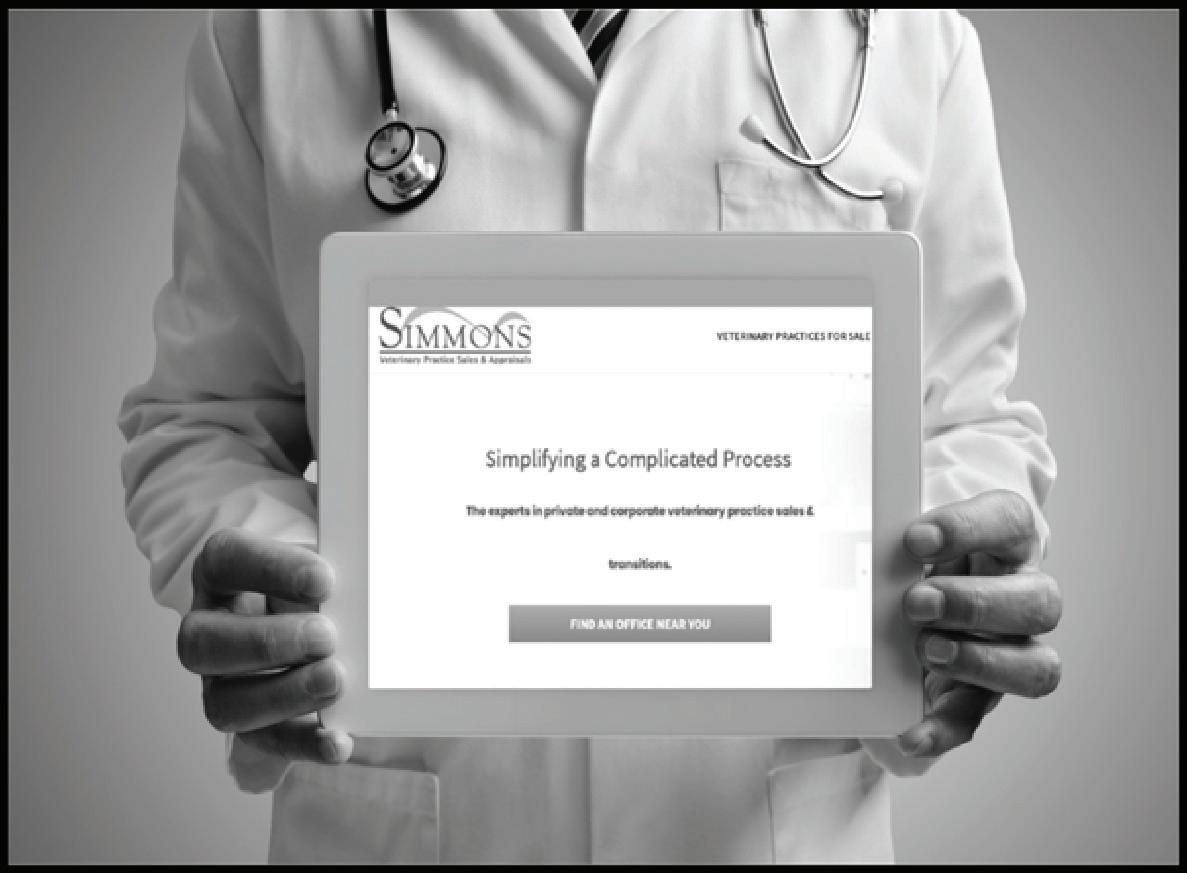
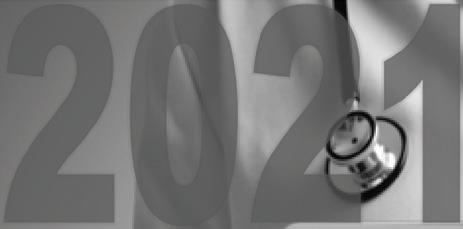























profession is unique.